Altiostar Networks 4451E400-3 AWS-3 band LTE Remote Radio Head User Manual
Altiostar Networks, Inc. AWS-3 band LTE Remote Radio Head Users Manual
Users Manual
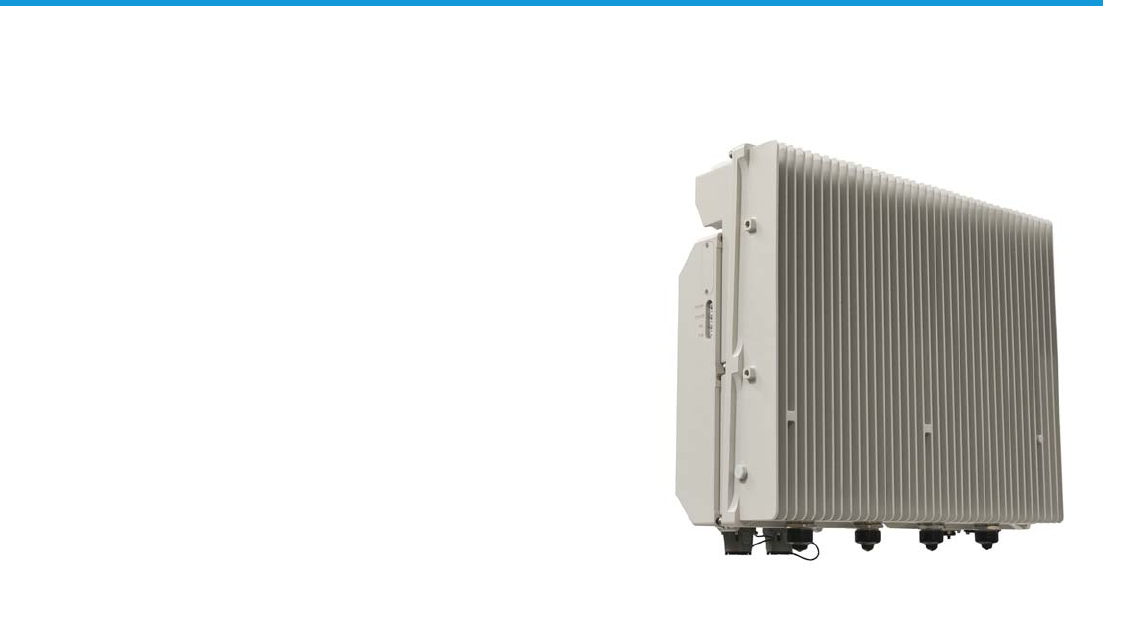
PN 240-00-0051
Revision 1.2
October 12, 2016
Altiostar Networks
iRM4451nn00-2
intelligent Remote Radio Head
Product Description and Installation Guide
iRM4451nn00-2
©Copyright 2017 Altiostar Networks, Inc.
All rights reserved.

iRM4451nn00-2 iRRH Product Description and Installation Guide
Copyright
© 2017 Altiostar Networks, Inc. All rights reserved. No part of this document may be
reproduced in any form without the written permission of the copyright owner. Altiostar
Networks, iR6, and the Altiostar Networks, Inc. logo are trademarks of Altiostar Networks,
Inc. All other trademarks are the property of their respective owners.
Disclaimer
All rights reserved. Information and product specification are subject to change without
notice as part of the company continuous process and methodology improvement. Altiostar
Networks assumes no responsibility for inaccuracies contained herein.

l Preface
iRM4451nn00-2 iRRH Product Description and Installation Guide P-i
Preface
About the document
This document covers the basic installation of the Altiostar Networks, Inc., iRM4451nn00-2
intelligent Remote Radio Head (iRRH) on towers, walls, roof or other structures inaccessible
to the general public.
Connections to external interfaces, including signaling, grounding, and power are described.
Descriptions of the iRM4451nn00-2 macro-cellular intelligent Remote Radio Head indicators
are also provided.
The iRB7200 virtual Baseband Unit (vBBU), the iRB1200 intelligent Baseband Unit and the
iRB2400 intelligent Baseband Unit are companion products. Refer to the Altiostar Networks
iRB1200 intelligent Baseband Unit Product Description and Installation Guide, document
number 240-00-0007, for related information.
Intended Users
The target audience for this document is installation and engineering personnel. It assumes
personnel have a basic understanding of wireless telecommunications terminology, and
experience in installing wireless telecommunications equipment.
Overview
The iRM4451nn00-2 intelligent Remote Radio Head is an energy-efficient outdoor macrocell
radio head with integrated baseband for use in several select frequency bands. Connection to
a vBBU, or the optional iRB1200 iBBU or iRB2400 iBBU, is through a Gigabit Ethernet (GigE)
connection. Connection to other compliant fronthaul devices can also be facilitated using the
Ethernet fronthaul port.
The iRM4451nn00-2 intelligent Remote Radio Head is based on a distributed architecture
with the following two essential elements:
• iRM4451nn00-2 iRRH
• iRB7200 vBBU, iRB1200 iBBU, or iRB2400 iBBU
The iRM4451nn00-2 iRRH is connected to the vBBU through a Gigabit Ethernet (GigE)
connection. Connection to other compliant fronthaul devices can also be facilitated using the
Ethernet fronthaul port.
The iRM4451nn00-2 iRRH interconnects with the described Altiostar baseband units which
operate within the RAN portion of the LTE wireless network.

Preface l
P-ii iRM4451nn00-2 iRRH Product Description and Installation Guide
iRM4451nn00-2 available models
Table P-1 provides information on the available iRM4451iRRH models and associated part
numbers. The model number for a specific model is in the form iRM4451nn00-2. For
example, if you order a model iRM44510400-2, you would get an iRM4451 with GPS and
Series-A connectors, operating in AWS Band 4 with Altiostar part number 509-03-0002.
Table P-2 provides top-level part numbers of available iRM4451nn00-a models.
Table P-1 iRM4451 iRRH models/configuration list
iRM4451 model naming
Base model +Band/Frequency
extension =Band/Frequency
0200-2 Band 2 (1.9 GHz) (Series-A connectors)
0300-2 Band 3 (1.8 GHz) (Series-A connectors)
0400-2 Band 4 (AWS) (Series-A connectors)
0700-2 Band 7 (2.6 GHz) (Series-A connectors)
E400-2 Band 66A (AWS & AWS-3) (Series-A connectors)
iRM4451 +0700-3 =Band 7 (2.6 GHz) (Series-A connectors)
70 MHz IBW, 40 MHz OBW
E400-3 Band 66A (AWS & AWS-3) (Series-A connectors)
70 MHz IBW, 40 MHz OBW
0200-3 Band 2 (PCS) (Series-A connectors)
0400-3 Band 4 (AWS) (Series-A connectors)
2500-3 Band 2 EXT (PCS) (Series-A connectors)
Table P-2 iRM4451nn00-2 iRRH part numbers
Model number Part number Descripton
iRM44510700-2 509-02-0001 iRM4451 iRRH Band 7 (2.6 GHz), GPS and
Series-A connectors
iRM44510400-2 509-03-0001 iRM4451 iRRH Band 4 (AWS), GPS and Series-A
connectors
iRM4451E400-2 509-04-0001 iRM4451 iRRH Band 66A (AWS & AWS-3), GPS
and Series-A connectors
iRM44510200-2 509-05-0001 iRM4451 iRRH Band 2 (1.9 GHz), GPS and
Series-A connectors

l Preface
iRM4451nn00-2 iRRH Product Description and Installation Guide P-iii
iRM44510300-2 509-06-0001 iRM4451 iRRH Band 3 (1.8 GHz), GPS and
Series-A connectors
iRM44510700-3 509-02-0003
iRM4451 iRRH Band 7 (2.6 GHz), GPS and
Series-A connectors
70 MHz IBW, 40 MHz OBW
iRM4451E400-3 509-04-0003
iRM4451 iRRH Band 66A (AWS & AWS-3), GPS
and Series-A connectors
70 MHz IBW, 40 MHz OBW
iRM44510200-3 340-00-0085 iRM4451 iRRH Band 2 (PCS), GPS and Series-A
connectors
iRM44510400-3 340-00-0TBD iRM4451 iRRH Band 4 (AWS), GPS and Series-A
connectors
iRM44512500-3 340-00-0086 iRM4451 iRRH Band 2 EXT (PCS), GPS and
Series-A connectors
Table P-2 iRM4451nn00-2 iRRH part numbers
Model number Part number Descripton

iRM4451nn00-2 iRRH Product Description and Installation Guide

Contents
iRM4451nn00-2 iRRH Product Description and Installation Guide i
Contents
1 Introduction ........................................................................... 1-1
1.1 Conventions used......................................................................... 1-1
1.2 Hardware components .................................................................. 1-2
2 Safety requirements............................................................... 2-1
2.1 Overview..................................................................................... 2-1
2.2 Purpose ...................................................................................... 2-1
2.3 Warning symbols.......................................................................... 2-1
2.4 General safety precautions ............................................................ 2-1
3 Physical description................................................................ 3-1
3.1 iRM4451nn00-2 iRRH boards and modules ....................................... 3-2
3.2 iRM4451nn00-2 iRRH controls, indicators connectors and components. 3-2
3.2.1 GPS connector...................................................................... 3-5
3.2.2 RF connectors ...................................................................... 3-5
3.2.3 Power connector................................................................... 3-6
3.2.4 RET connector...................................................................... 3-8
3.2.5 Fronthaul connectors............................................................. 3-8
3.2.6 Alarms connector................................................................ 3-10
3.2.7 Access panel (factory use only) ............................................ 3-11
3.2.8 LED indicators .................................................................... 3-11
3.2.9 Vent port........................................................................... 3-13
4 Installation prerequisites ....................................................... 4-1
4.1 Required tools.............................................................................. 4-1
4.2 Required site equipment................................................................ 4-3
4.3 Site preparation ........................................................................... 4-4
4.4 Site pre-installation visit checklist................................................... 4-4
4.5 Site installation checklist ............................................................... 4-6
5 Installation overview.............................................................. 5-1
5.1 Installation procedures.................................................................. 5-1
5.2 Unpacking the shipping container ................................................... 5-1
5.3 Verifying all parts received............................................................. 5-2
6 Installing the iRM4451nn00-2 ................................................ 6-1
6.1 Assembling cables ........................................................................ 6-1
6.1.1 Verify Installer-supplied –48 V dc power cable.......................... 6-1
6.1.2 Verify Installer-supplied GigE optical cable ............................... 6-1
6.1.3 Verify Installer-supplied grounding cable.................................. 6-1
6.2 Routing pre-assembled power/GigE optical fronthaul/grounding cables 6-2
6.3 Installing the mounting bracket...................................................... 6-4
6.3.1 Mounting on a pole/mast ....................................................... 6-4
6.3.2 Mounting on a wall................................................................ 6-5
6.4 Hoisting the iRM4451nn00-2 on elevated structures.......................... 6-6
6.5 Installing the iRM4451nn00-2 on the mounting bracket ..................... 6-7

Contents
ii iRM4451nn00-2 iRRH Product Description and Installation Guide
6.6 Connecting the grounding cable...................................................... 6-8
6.7 Connecting the RET cables............................................................. 6-9
6.8 Connecting the GigE optical fronthaul cables .................................. 6-10
6.9 Connecting the RF cables............................................................. 6-10
6.10 Connecting the alarms cable ...................................................... 6-11
6.11 Connecting the –48 V dc power cable .......................................... 6-11
6.12 Weatherproofing cable connections ............................................. 6-11
6.13 Checking power........................................................................ 6-12
7 Terms, Acronyms and Abbreviations...................................... 7-1

List of tables
iRM4451nn00-2 iRRH Product Description and Installation Guide v
List of tables
Table P-1 iRM4451 iRRH models/configuration list ........................................P-ii
Table P-2 iRM4451nn00-2 iRRH part numbers..............................................P-ii
Table 3-1 Altiostar Networks iRM4451nn00-2 iRRH technical specifications ..... 3-2
Table 3-2 iRM4451nn00-2 iRRH connectors ................................................ 3-5
Table 3-3 Lumberg 0315 12 alarm connector details.................................. 3-10
Table 3-4 LED indicators description and operating characteristics............... 3-12
Table 3-5 LED blink rates....................................................................... 3-12
Table 3-6 LED indicators boot-up sequence .............................................. 3-13
Table 4-1 Required tools.......................................................................... 4-1
Table 4-2 iRM4451nn00-2 iRRH Installer-supplied parts list .......................... 4-4
Table 4-3 Site pre-installation visit checklist ............................................... 4-5
Table 4-4 Site installation checklist............................................................ 4-6
Table 5-5 iRM4451nn00-2 iRRH parts list ................................................... 5-3

List of tables
vi iRM4451nn00-2 iRRH Product Description and Installation Guide

List of figures
iRM4451nn00-2 iRRH Product Description and Installation Guide iii
List of figures
Figure 1-1 iRM4451nn00-2 iRRH functional block diagram .......................... 1-2
Figure 3-1 Altiostar networks iRM4451nn00-2 iRRH .................................... 3-1
Figure 3-2 iRM4451nn00-2 iRRH RF connectors location .............................. 3-3
Figure 3-3 iRM4451nn00-2 iRRH RET and –48v DC (power) connector location3-3
Figure 3-4 iRM4451nn00-2 iRRH GPS and fronthaul connectors location ........ 3-4
Figure 3-5 iRM4451nn00-2 iRRH ground connector location ......................... 3-4
Figure 3-6 –48 V DC 2-pin Rosenberger bulkhead jack................................ 3-6
Figure 3-7 Rosenberger –48 V DC power plug (exploded view)..................... 3-7
Figure 3-8 Cable connection for supplied 2-pin Rosenberger plug ................. 3-7
Figure 3-9 RET standard 8-pin DIN connector ............................................ 3-8
Figure 3-10 Rosenberger RFE fiber-optic enclosure ..................................... 3-9
Figure 3-11 iRM4451nn00-2 SPM module, Test Access Panel and LED panel. 3-11
Figure 3-12 Vent port........................................................................... 3-14
Figure 6-1 Grounding terminal lug assembled on grounding cable................. 6-2
Figure 6-2 iRM4451nn00-2 cable routing................................................... 6-3
Figure 6-3 iRM4451nn00-2 mounting plate................................................ 6-4
Figure 6-4 Installing mounting bracket on a pole........................................ 6-5
Figure 6-5 Hoist line carabiner attachment points....................................... 6-7
Figure 6-6 Aligning mounting plate tabs to mounting bracket....................... 6-8
Figure 6-7 Connecting the grounding cable................................................ 6-9
Figure 6-8 Weatherproofing connections using self-fusing tape................... 6-12

List of figures
iv iRM4451nn00-2 iRRH Product Description and Installation Guide

Introduction
iRM4451nn00-2 iRRH Product Description and Installation Guide 1-1
1 Introduction
1.1 Conventions used
Illustrations and photos in this document are intended to show a basic installation.
They show site and equipment configurations encountered during a typical
installation. They do not show all details and exceptions, but highlight the main points
of the installation.
Altiostar Networks, Inc. will often be referred to as Altiostar Networks, or simply
Altiostar.
The Altiostar Networks iRM4451nn00-2 intelligent Remote Radio Head will often be
referred to in the generic as the iRM4451nn00-2 iRRH, iRM4451nn00-2, or simply the
iRRH. When referring to a specific model, the full model name will be used. For
example, the iRM44510300-2 (Band 3, 1.8 GHz, with GPS external connector and
Series A connectorization). Refer to “iRM4451nn00-2 available models” in the
“Preface” to this document.
The Altiostar Networks iRB7200 virtual Baseband Unit (vBBU) is a server-based
companion unit to the iRM4451nn00-2 in the Altiostar Networks LTE macro eNodeB
solution.
The Operator or Owner of the facility and equipment where the iRM4451I00-2 iRRH is
to be installed is referred to as the Operator in this document.
The Installer may be the Operator, or any other entity assigned and approved by the
Operator, to perform the installation of the iRRH at specified Operator facilities.
NOTE
This is an example of a note used in this document that denotes important
information about the text or procedure that follows it.
The iRM4451nn00-2 interconnects with compliant radio antennas and the associated
baseband unit, i.e., vBBU (or the optional iRB1200/iRB2400 iBBUs) which operate
within the RAN portion of the LTE wireless network.
A block diagram of the iRM4451nn00-2 iRRH is shown in Figure 1-1.
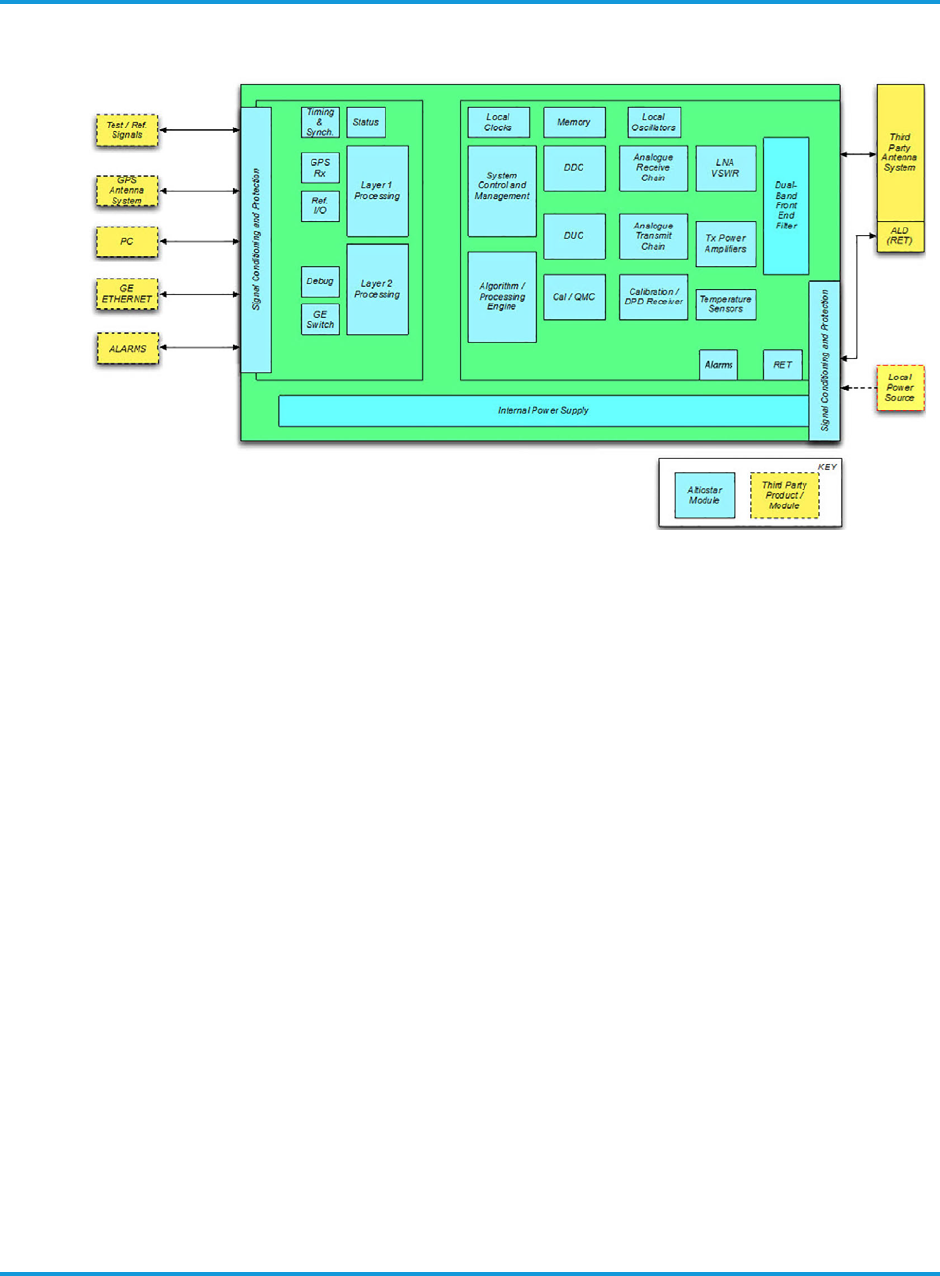
Introduction
1-2 iRM4451nn00-2 iRRH Product Description and Installation Guide
Figure 1-1 iRM4451nn00-2 iRRH functional block diagram
1.2 Hardware components
The following major circuit cards and components comprise the iRM4451nn00-2 iRRH.
See Figure 1-1.
• Signal Processing Module
•Radio Card
• Signal Conditioning and Protection
• Internal power supply
• Front-end Filter
• Fronthaul Interface
•Local PC
• GPS Receiver System
• Test/Reference Signals
• RF Antenna System
•Local Power Source
• Alarms Interface
The iRM4451nn00-2 gets its power from an external –48 V DC source. Antennas,
supplied by the Operator, are used for RF transmission and Global Positioning System
(GPS) reception.

Introduction
iRM4451nn00-2 iRRH Product Description and Installation Guide 1-3
The Signal Processing Module (SPM) provides single carrier, single band, single sector
LTE eNodeB operation; it is the Gigabit interface to the Altiostar base station unit
(vBBU). It also provides for 20 MHz (max) instantaneous carrier bandwidth (IBW)
support for 3GPP LTE Release 11 advanced features, L1/L2 signal conditioning, signal
protection and signal processing of the fronthaul signal inputs, as well as eNodeB
timing recovery and synchronization from either the external GPS antenna or 1588V2
extraction of timing from the Layer 2 stratum. It supports test and reference signal
I/O for radio conformance testing (RCT), and Data and Control interface to the radio
card.
An external alarms input is located on the side of the iRM4451 unit. There are four
sets of 2-wire dry contacts that can be software-configured to be normally open or
normally closed.
Test and Debug ports (both factory use only) are provided via a mini USB port and an
HDMI port located behind an access panel on the front of the unit.

Introduction
1-4 iRM4451nn00-2 iRRH Product Description and Installation Guide
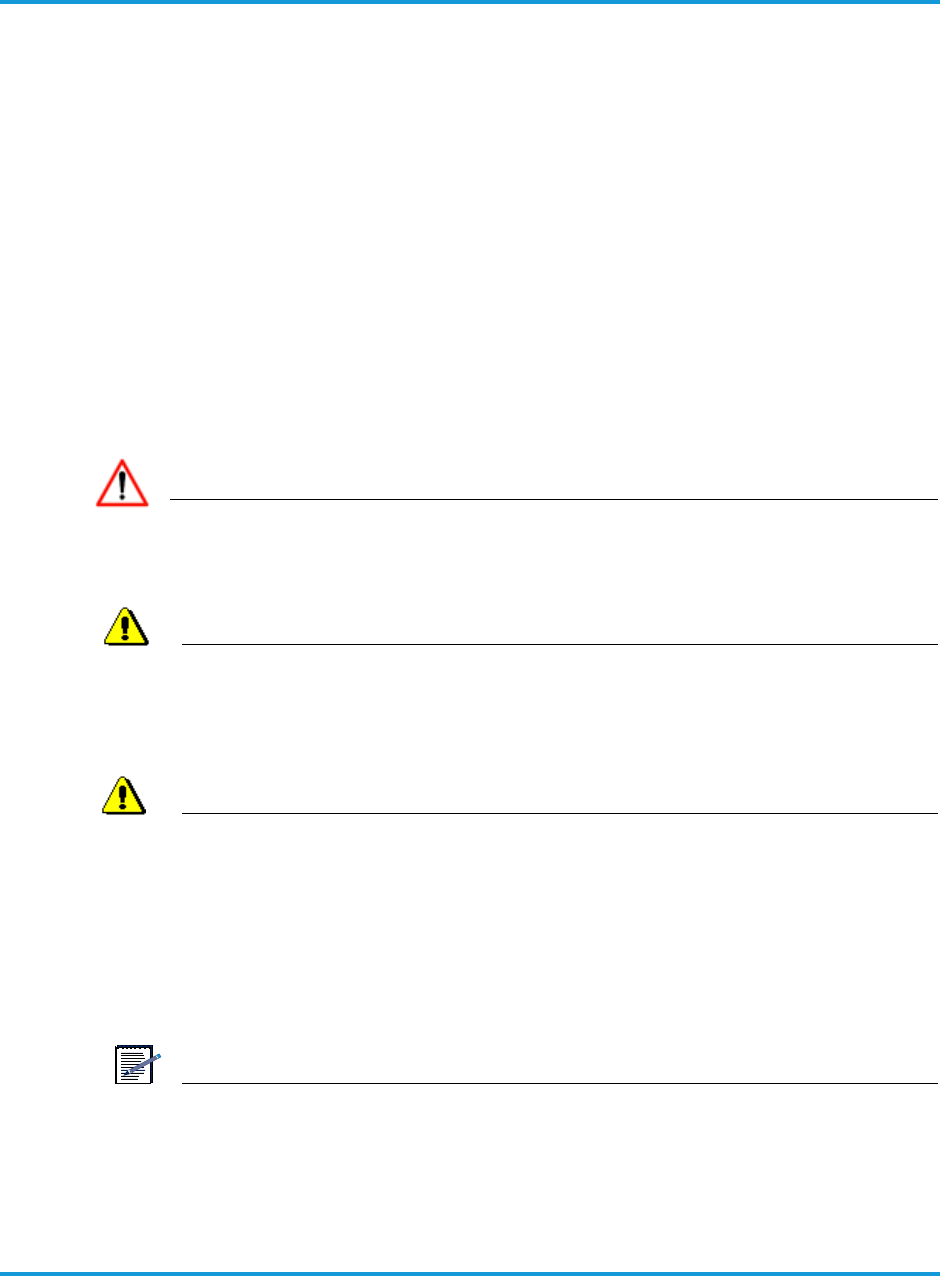
Safety requirements
iRM4451nn00-2 iRRH Product Description and Installation Guide 2-1
2 Safety requirements
2.1 Overview
This section provides safety precautions that apply to the iRM4451 iRRH. The
precautions statements are required by national or regional standards institutes in the
country or region where they apply. This document complies with these requirements.
2.2 Purpose
To protect installation personnel, equipment and operations, this document contains
safety statements. Safety statements are provided at points in procedures where
risks may exist to personnel, equipment and network operations. Failure to follow the
directions in the safety statements may result in serious consequences.
2.3 Warning symbols
DANGER
Danger is used to indicate the presence of a hazard that will cause
severe personal injury, death, or substantial property damage if the
hazard is not avoided.
WARNING
Warning is used to indicate the presence of a hazard that can cause
severe personal injury, death, or substantial property damage if the
hazard is not avoided.
CAUTION
Caution is used to indicate the presence of a hazard that will or can
cause minor personal injury or property damage if the hazard is not
avoided.
2.4 General safety precautions
Safety precautions should be observed when performing these installation
procedures.
NOTE
The safety precautions found in this section are only intended to supplement
those safety precautions already proscribed by the Operator—who is responsible
for communicating them clearly to the Installer.
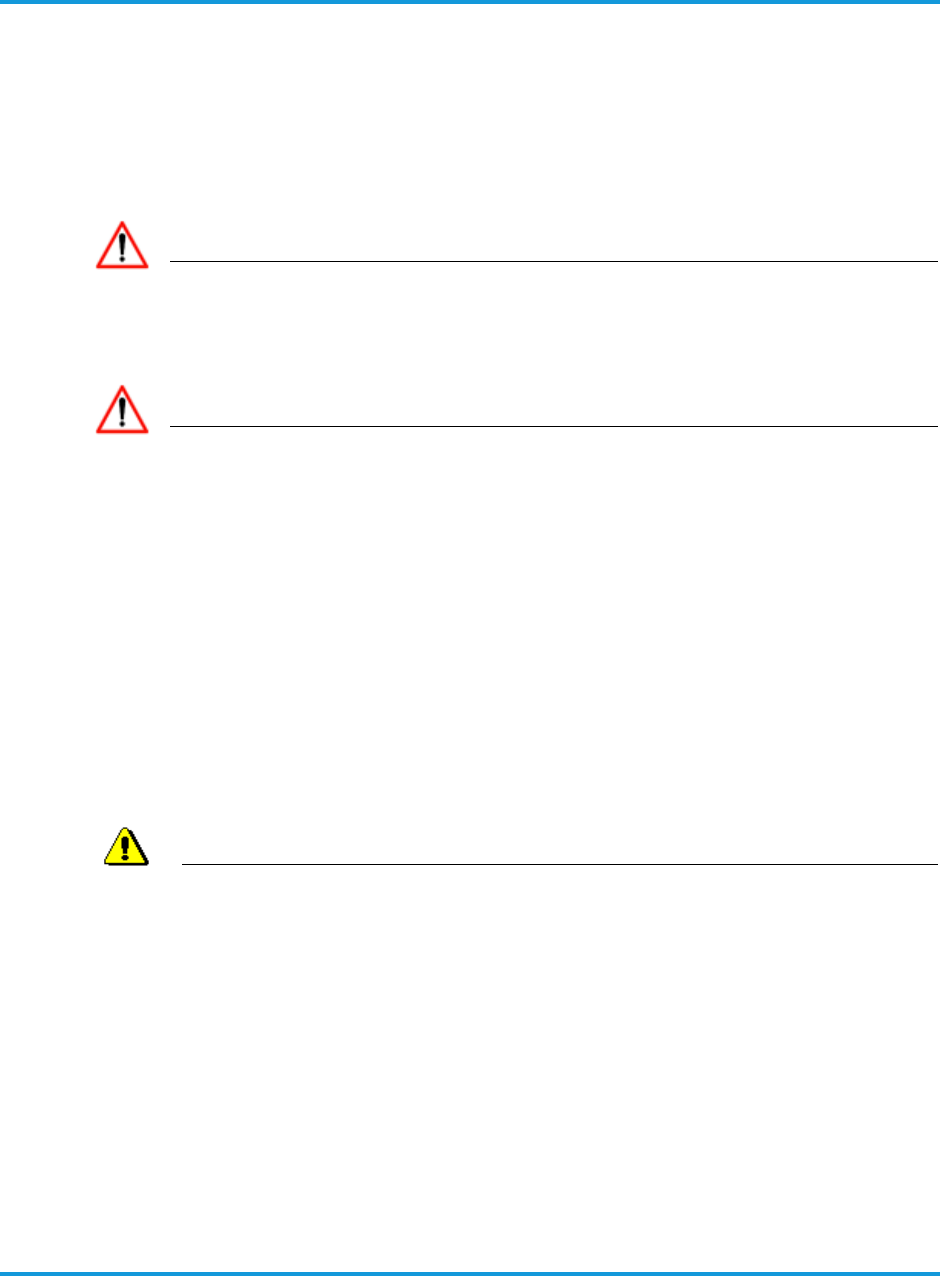
Safety requirements
2-2 iRM4451nn00-2 iRRH Product Description and Installation Guide
The power system and RET cables will have hazardous energy and voltages present.
Follow all safety warnings and practices when servicing this equipment.
This equipment must be installed, serviced, and operated only by authorized,
qualified and trained personnel who have the necessary knowledge and practical
experience with electrical equipment and who understand the hazards that can arise
when working on this type of equipment. Observe all local and national electrical,
environmental and workplace codes.
DANGER
HAZARDOUS VOLTAGES!
Hazardous voltages can be present when the system is operating. Use
caution when removing or installing equipment.
DANGER
FALL HAZARD!
A fall hazard is present when installation of this equipment requires
working on towers, poles or at elevated work sites. All telecommunications
personnel who perform tower work or work at elevation must be qualified
to perform this type work.
Installation of this equipment may require working on towers, poles or at
elevated work sites. All telecommunications personnel who perform tower
work or work at elevation must be trained and qualified to perform this
work, have the proper equipment to perform the work safely, and follow all
requirements in accordance with 29 CFR 1910.268, 29 CFR 1926, and any
other safety requirements in force by the Operator, or local and regional
authorities. In addition, the tower or structure must be certified safe for
climbing according to TIA/EIA 222 and 29 CFR 1910.66, Appendix C for
anchorage devices.
WARNING
Read and understand all instructions before starting this procedure!
•Follow all warnings and safety instructions in this procedure.
• Only trained personnel should install or operate this equipment.
• Observe all local and national electrical, environmental and workplace
codes.
• Before working on equipment that is connected to power, remove
jewelry (including rings, necklaces, and watches). Metal objects will
heat up when connected to power and ground and can cause serious
burns or weld the metal object to the terminals.
• The equipment must have a direct disconnect device in line with the
power source.

Safety requirements
iRM4451nn00-2 iRRH Product Description and Installation Guide 2-3
• Grounding and circuit integrity is vital to a safe operating environment.
Grounding conductors must be in place before installing the equipment.
Never operate equipment when grounding or bonding conductor has
been removed.
• Never install equipment not identified in this procedure. Fire or injury
could result from improperly installed equipment.
• Caution should be exercised when installing or modifying
telecommunications lines.
• Disconnect all power sources before servicing the equipment.
• Never touch uninsulated wiring or terminals unless power to the lines
have been disconnected at the source. Always verify power has been
removed using an approved voltage tester.
• To prevent electrical shock, never remove the cover or disassemble the
equipment. There are no user serviceable components in the
equipment.
• Never insert probes or objects of any kind into slots or openings to the
equipment. Dangerous voltages may be present or the object may
cause a short circuit and start a fire or damage the equipment.
CAUTION
HOT SURFACES!
• Under certain conditions, specifically during and immediately after
prolonged operation, the unit can be hot. Wait for unit to cool before
performing maintenance or use insulating gloves.
CAUTION
HEAVY OBJECT!
• Assisted carry ONLY! This object is heavy; over 75 lb. (34.0 kg). Follow
instructions when lifting unit from shipping container and hoisting onto
mounting bracket. Requires a minimum of two people to lift and hand
carry the unit.
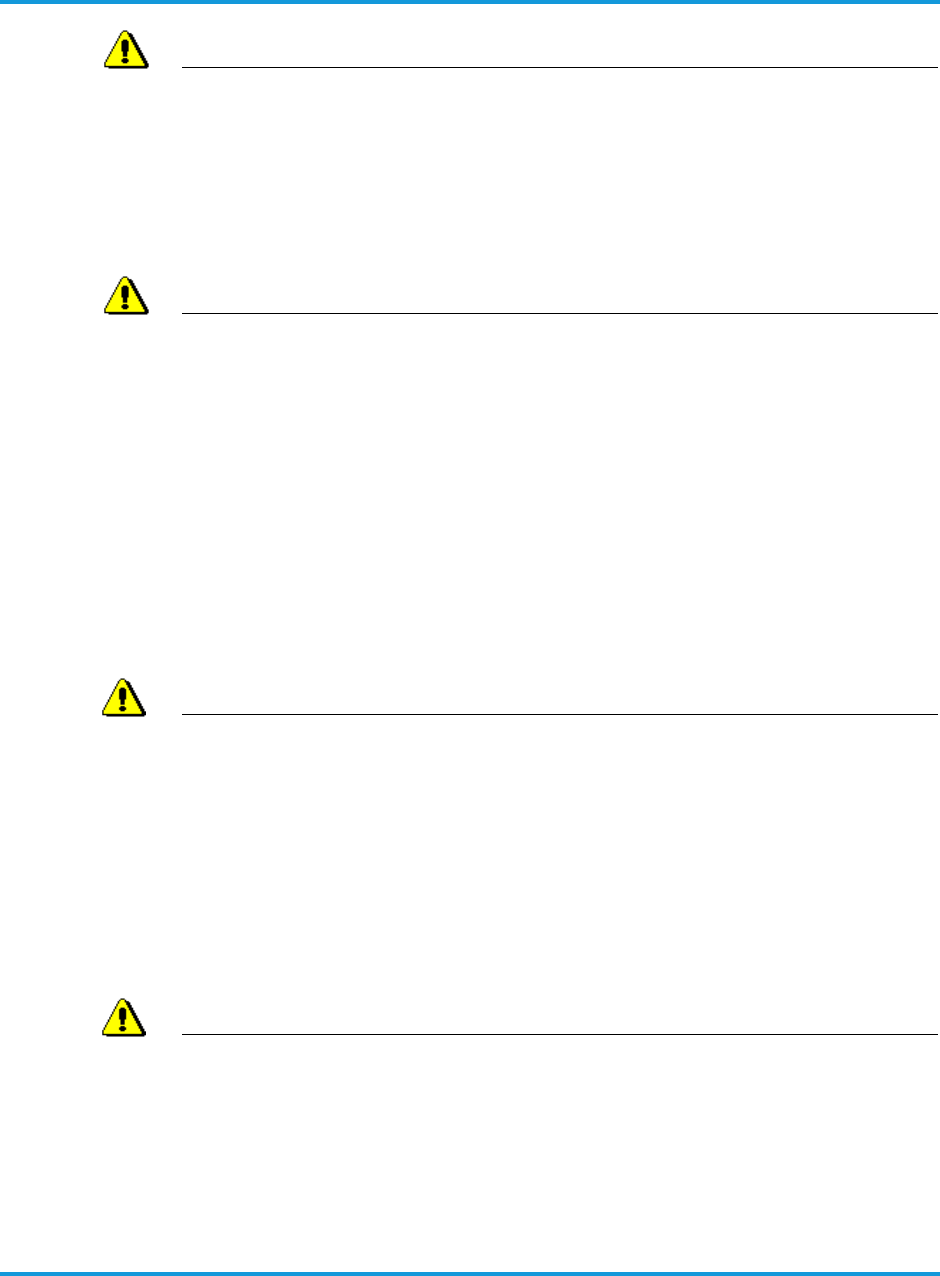
Safety requirements
2-4 iRM4451nn00-2 iRRH Product Description and Installation Guide
WARNING
LIGHTNING STRIKE HAZARD!
• Lightning strikes are possible during stormy weather. Do not install
equipment if stormy conditions exist.
• Never work on telecommunications power supply lines or antenna
feeders at the cell site during stormy conditions.
WARNING
SHOCK HAZARD!
• Some parts of all electrical systems are energized at all times. Exercise
extreme caution at all times when working around telecommunications
electrical systems. Short circuits can cause burns to the face or hands.
Failure to observe this and other safety warnings may lead to bodily
injury and property damage.
• Only trained and qualified personnel may install or service equipment
as defined in IEC 215 and EN 60215.
• Turn off or disconnect equipment from its energy source(s) by
switching off the load disconnect switch in the distribution panel before
performing service or maintenance.
CAUTION
LASER RADIATION AND FIBER OPTIC CABLE USE CAUTION!
• Class 1 invisible laser radiation present. Avoid long-term viewing of
laser. Never use a magnifying device to view optical fiber ends when
fiber is connected to equipment.
• Fiber optic cables may be damaged if bent or curved to a radius that is
less than the recommended minimum bend radius of two inches.
Always observe the recommended bend radius limit when installing
fiber optic cables and patch cords.
CAUTION
SHORT CIRCUIT HAZARD!
Condensation on the equipment has a potential to cause short circuits!
Weather conditions may exist at the site where condensation may form on
the equipment. Installing or operating the equipment when condensation is
present may cause a short circuit and damage the equipment.
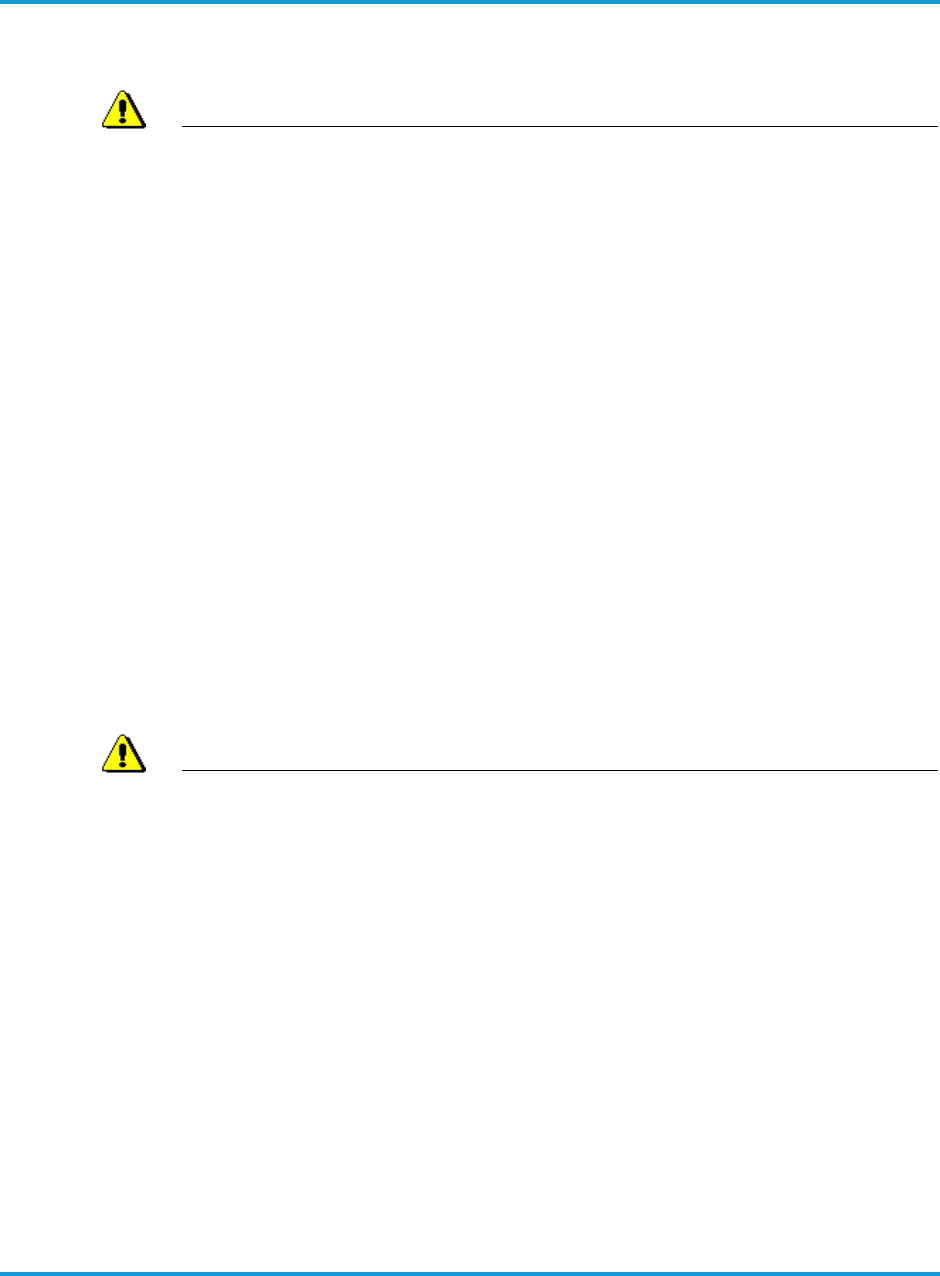
Safety requirements
iRM4451nn00-2 iRRH Product Description and Installation Guide 2-5
Equipment showing signs of condensation should be allowed to dry before
installation.
CAUTION
ELECTROSTATICALLY SENSITIVE EQUIPMENT!
Semiconductor components are sensitive to electrostatic electricity and
may be damaged by static discharge.
When handling the equipment, the following rules must be followed:
• Wear conductive or anti-static clothing.
• Wear grounded ESD wrist strap.
• Wear shoes with conductive straps or soles.
• Verify anti-static safety devices are operating properly by testing
yourself at an approved test station.
• Leave equipment in their original anti-static wrapping until ready for
installation.
• When handling equipment or modules, use handles provided to carry
the device and do not touch electrical contacts, pins or components.
• Only place equipment or modules on conductive surfaces.
• Use tools on equipment or modules only when equipment is grounded.
• Handle defective equipment or modules similarly to new equipment to
prevent additional damage.
CAUTION
GROUNDING CAUTION!
• This equipment's grounding connection is between the DC power circuit
and the grounding conductor.
• This equipment must have a direct connection to the DC supply
grounding point or to a bonding jumper from the grounding terminal
bus bar to the DC supply ground electrode for the site.
• The grounding circuit must not have a disconnect device located in line
with the DC circuit grounding conductor.

Safety requirements
2-6 iRM4451nn00-2 iRRH Product Description and Installation Guide
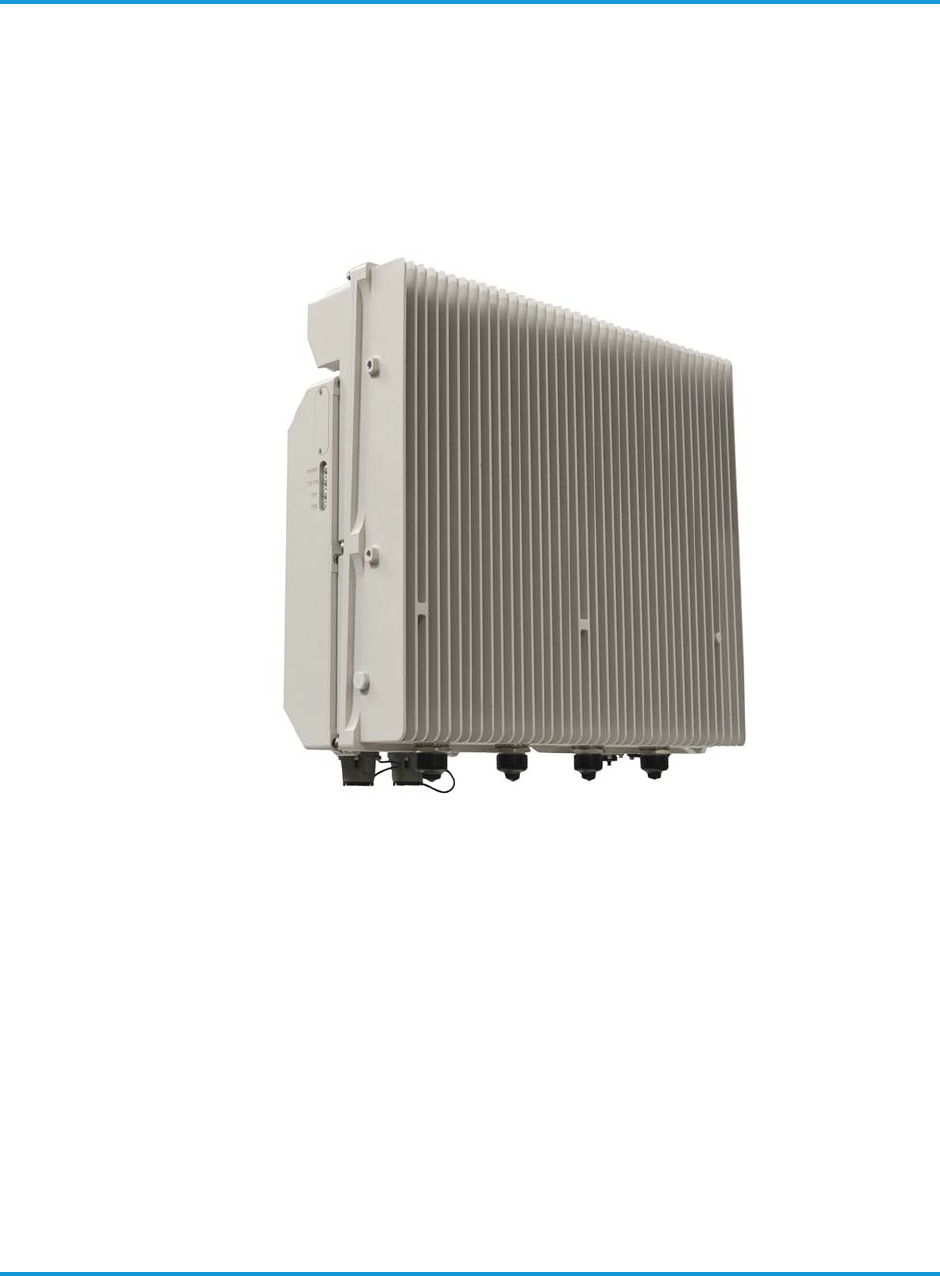
Physical description
iRM4451nn00-2 iRRH Product Description and Installation Guide 3-1
3 Physical description
The Altiostar Networks iRM4451nn00-2 intelligent Remote Radio Head is an energy-
efficient, modular, outdoor radio unit constructed of aluminum with integrated heat
sink fins to facilitate fanless convection cooling. Four independent RF outputs for a
4T4R configuration at 30 W per RF path for a total of 120 W maximum output power.
The iRM4451nn00-2 iRRH has connections for –48 V DC power input and Gigabit
Ethernet optical fronthaul. Figure 3-1 shows the iRM4451nn00-2 iRRH.
Figure 3-1 Altiostar networks iRM4451nn00-2 iRRH
The Altiostar Networks iRM4451nn00-2 iRRH can be mounted on a wall, mast or tower
using the supplied mounting bracket assembly and mounting plate. Table 3-1 lists the
model numbers for specific bands, and specifications of the iRM4451nn00-2 iRRH by
characteristic type. The Installer is responsible for supplying and installing antennas
and associated cables for the GPS and RF signals. For recommendations on the
antenna type, the RET motor, and the RET cable assembly contact Altiostar Networks
engineering prior to the site pre-installation visit.
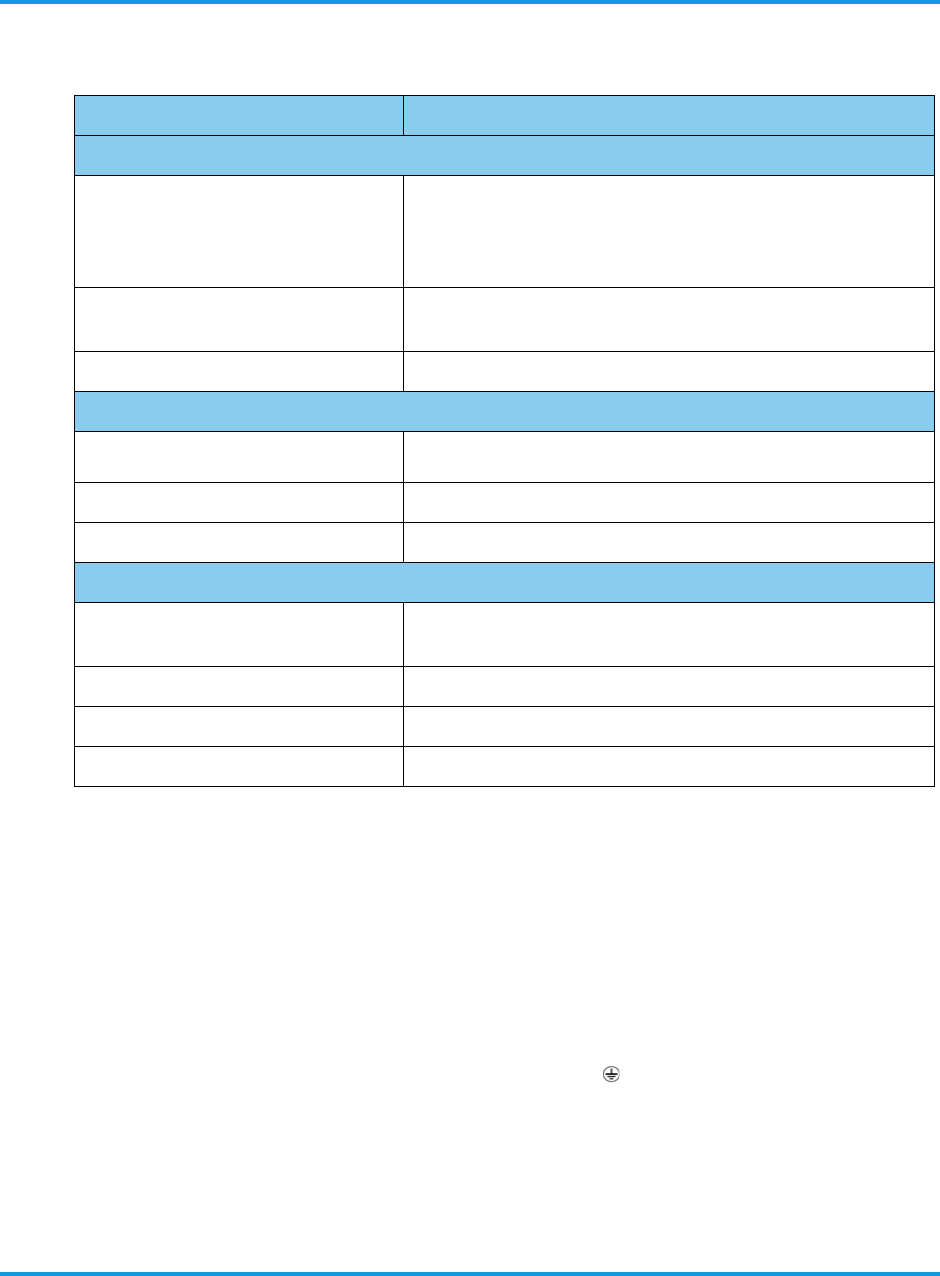
Physical description
3-2 iRM4451nn00-2 iRRH Product Description and Installation Guide
.
3.1 iRM4451nn00-2 iRRH boards and modules
The iRM4451nn00-2 intelligent Remote Radio Head is an integral unit with no user-
accessible boards or modules.
3.2 iRM4451nn00-2 iRRH controls, indicators connectors and
components
There are no controls on the macro iRRH. The connectors are located on the bottom of
the unit. They are for Global Positioning System antenna (GPS), Power (–48v DC),
RF (ANT1–ANT4), Fronthaul (FH1/FH2), Ground ( ), and Remote Electrical Tilt
(RET).
LEDs for Fronthaul 1 (FH1), Fronthaul 2 (FH2), STATUS, and POWER are located on
the side of the unit and are visible when the solar shield is installed.
Table 3-1 Altiostar Networks iRM4451nn00-2 iRRH technical specifications
Item Specification
Physical
Dimensions (H×W×D)
- Excludes solar shield
Radio Module
SPM
17.7 × 21.1 × 6.3 in (450 × 535 × 161 mm)
13.8 × 6.0 × 0.9 in (350 × 152 × 24 mm)
Weight
- Excludes brackets 73.8 lb (33.5 kg)
Volume < 40.0 L
Electrical
Input power –48 V DC
Current 18 A
Power distribution breaker/fuse 20 A (external)
Environmental
Working temperature (non-condensing
humidity
–40° to 131° F (–40° to 55° C)
Operating altitude –197 to 9,843 ft (–60 to 3000 m)
Relative humidity 5 to 100%
Cooling Convection (fanless)
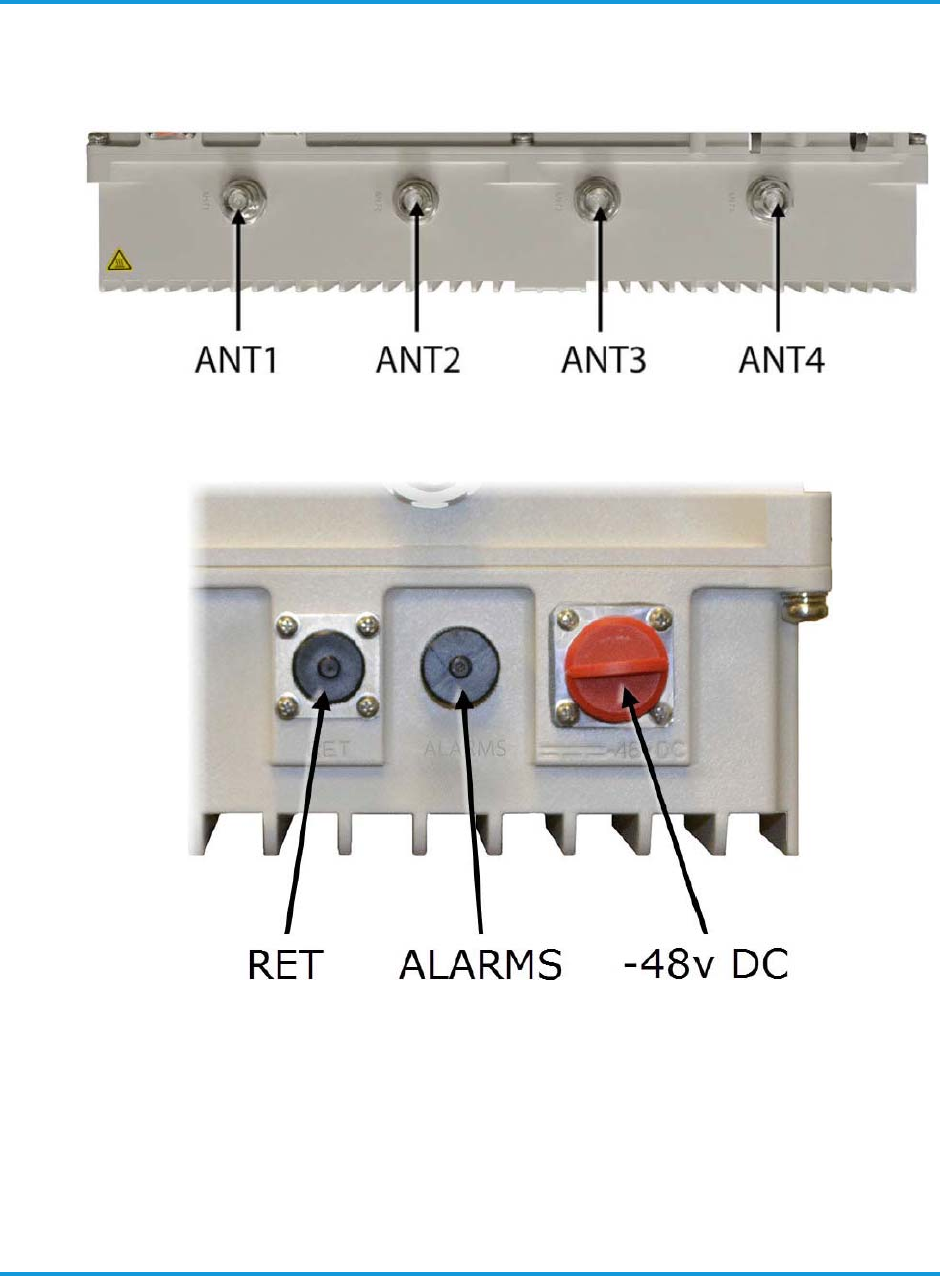
Physical description
iRM4451nn00-2 iRRH Product Description and Installation Guide 3-3
Connector locations for RF input/output are shown in Figure 3-2. Connector locations
for –48 V DC Power and Remote Electrical Tilt are shown in Figure 3-3. Connector
locations for GPS antenna and fronthaul are shown in Figure 3-4.
Figure 3-2 iRM4451nn00-2 iRRH RF connectors location
Figure 3-3 iRM4451nn00-2 iRRH RET and –48v DC (power) connector location
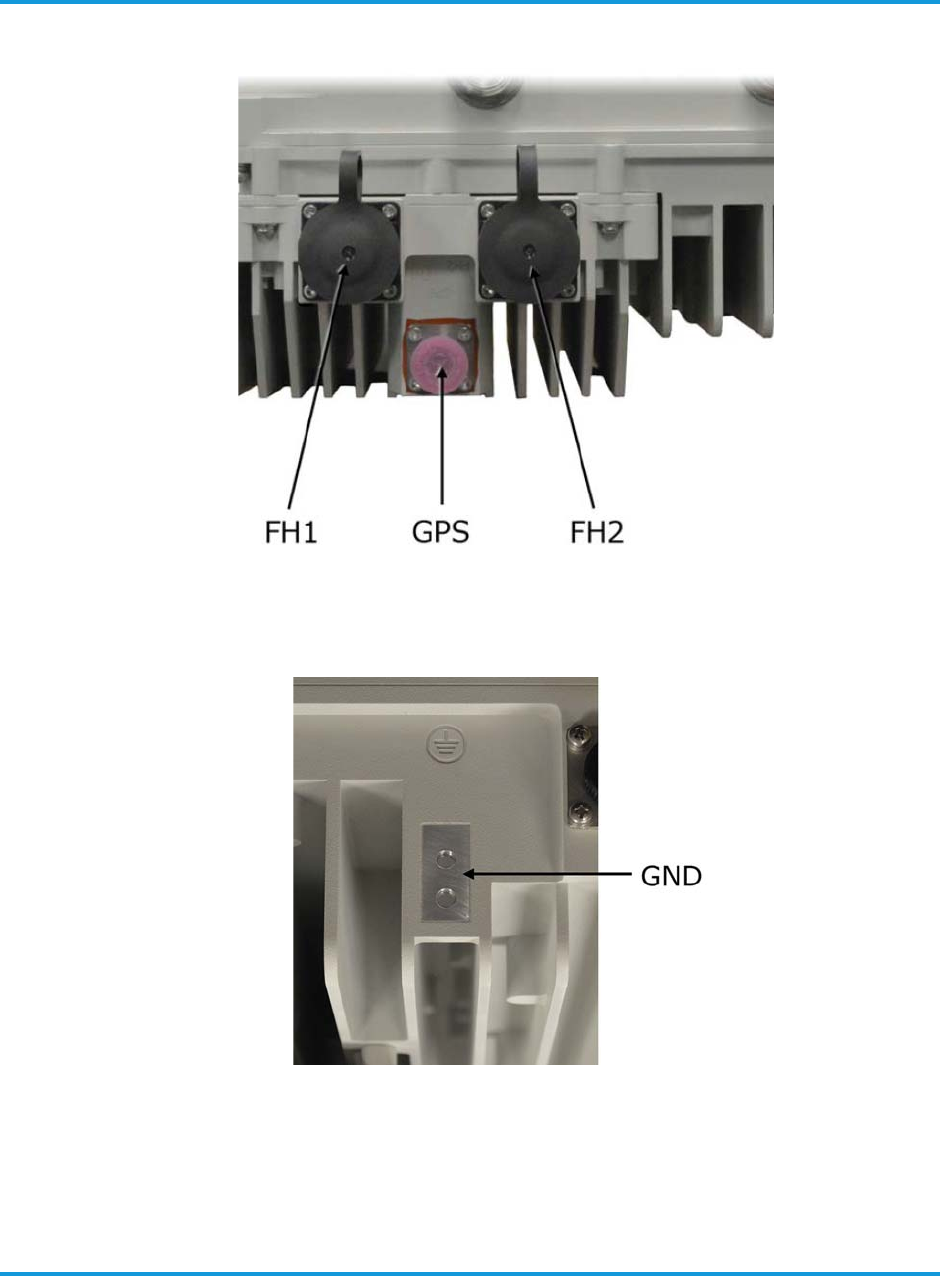
Physical description
3-4 iRM4451nn00-2 iRRH Product Description and Installation Guide
Figure 3-4 iRM4451nn00-2 iRRH GPS and fronthaul connectors location
Figure 3-5 iRM4451nn00-2 iRRH ground connector location

Physical description
iRM4451nn00-2 iRRH Product Description and Installation Guide 3-5
3.2.1 GPS connector
There is a 50-Ω GPS SMA female connector located on the bottom of the
iRM4451nn00-2 iRRH as shown in Figure 3-4.
A GPS mounting kit is provided which allows mounting the GPS antenna on the
macro iRRH or, if required, in a remote location if it is necessary to obtain an
unobstructed view of the sky. The kit will include a bracket with mounting
fasteners, and a GPS antenna with integrated cable terminated with an N-male
connector in a length specified in the Site Plan.
For installations where multiple equipment share a remote antenna, the Installer
must supply any splitter/combiner/amplifier and other additional GPS cables,
connectors or hardware as required in the Site Plan.
The GPS cable bend radius is .0.75 in (19 mm).
3.2.2 RF connectors
There are four 50-Ù, 4.3-10 female RF jacks that terminate on the bottom of the
iRM4451nn00-2 (see Figure 3-2). They are marked, from left to right, ANT4
Table 3-2 iRM4451nn00-2 iRRH connectors
Connection Control/Connector Type Quantity Function
–48v DC
Rosenberger 2-pin
connector (PN 99K73E-
199N1)
1–48 V DC power input
(GND) Dual-hole lug terminal 1Equipment grounding
GPS N (female), 50 Ù 1Timing source input
RET 8-pin circular DIN 1
Provides +24 V DC and RS5
control function for AISGv2.0-
compliant antenna remote
electrical tilt
FH1 Gigabit Ethernet optical
SFP modules, Rosenberger
Fiber Enclosure (RFE)
flange (PN 98Z405-K00)
1
Fronthaul data
FH2 1
ANT1–ANT4 4.3-10 conn (female)
threaded coupling, 50 Ù 4RF to directional antennas
ALARMS
Lumberg 03 series, 12-pin
screw-lock circular DIN,
50 Ω
1Alarms aggregation
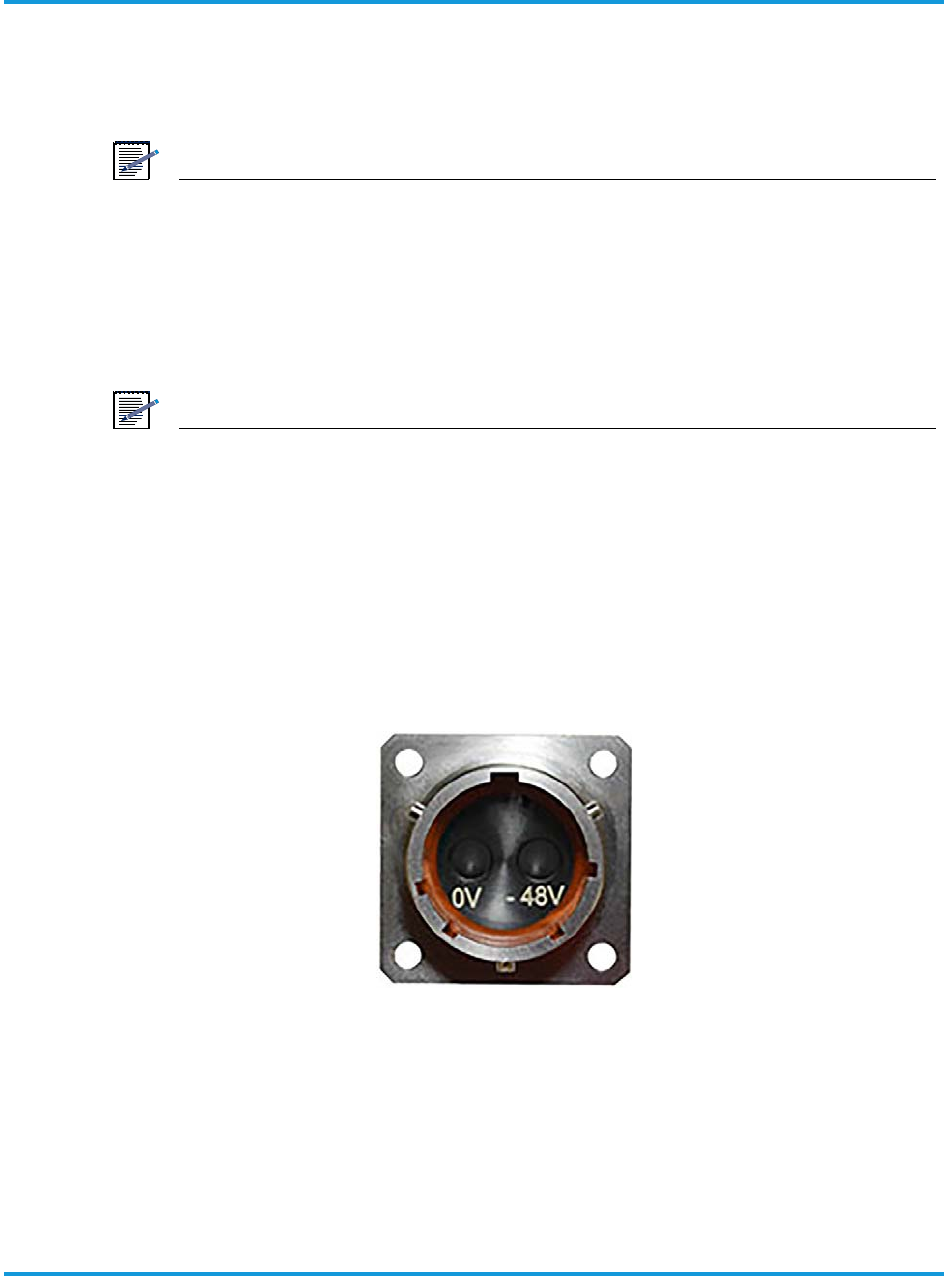
Physical description
3-6 iRM4451nn00-2 iRRH Product Description and Installation Guide
through ANT1. The RF cables are supplied and pre-installed by the Installer in
lengths according to site requirements.
The 4.3-10 RF jack screw connector is secured by torquing the coupling nut to
44.25 in-lb (5 Nm) using a torque wrench.
NOTE
The Installer is also responsible for determining the antenna type, and supplying
and pre-installing the antennas at the site.
The recommended RF jumper cable is an IP-68 compliant, Amphenol 4.3-10, male
to 7/16 DIN male, with super flex cable (Part No. AAS-12HF-43SMDM-xM). The
variable x is the length of the jumper in meters, where x = 1.0, 2.5, or 5.0. The RF
jumper cable minimum bend radius is 1.2 in (30 mm).
NOTE
It is recommended that all RF cables be PIM-tested on site to ensure acceptable
performance.
3.2.3 Power connector
–48 V DC power to the iRM4451nn00-2 iRRH is through a 2-pin, EMI shielded,
circular twist-lock quick connect bulkhead jack, Rosenberger (99K73E-199N1).
The connector is keyed to prevent mis-mating. The power connector pin
assignments, as viewed from the bottom of the iRM4451nn00-2, are shown in
Figure 3-6.
Figure 3-6 –48 V DC 2-pin Rosenberger bulkhead jack
The iRM4451nn00-2 comes supplied with an unconnectorized mating plug
(Rosenberger 99S73B-199N1) in a kit (Figure 3-7). The Installer assembles the
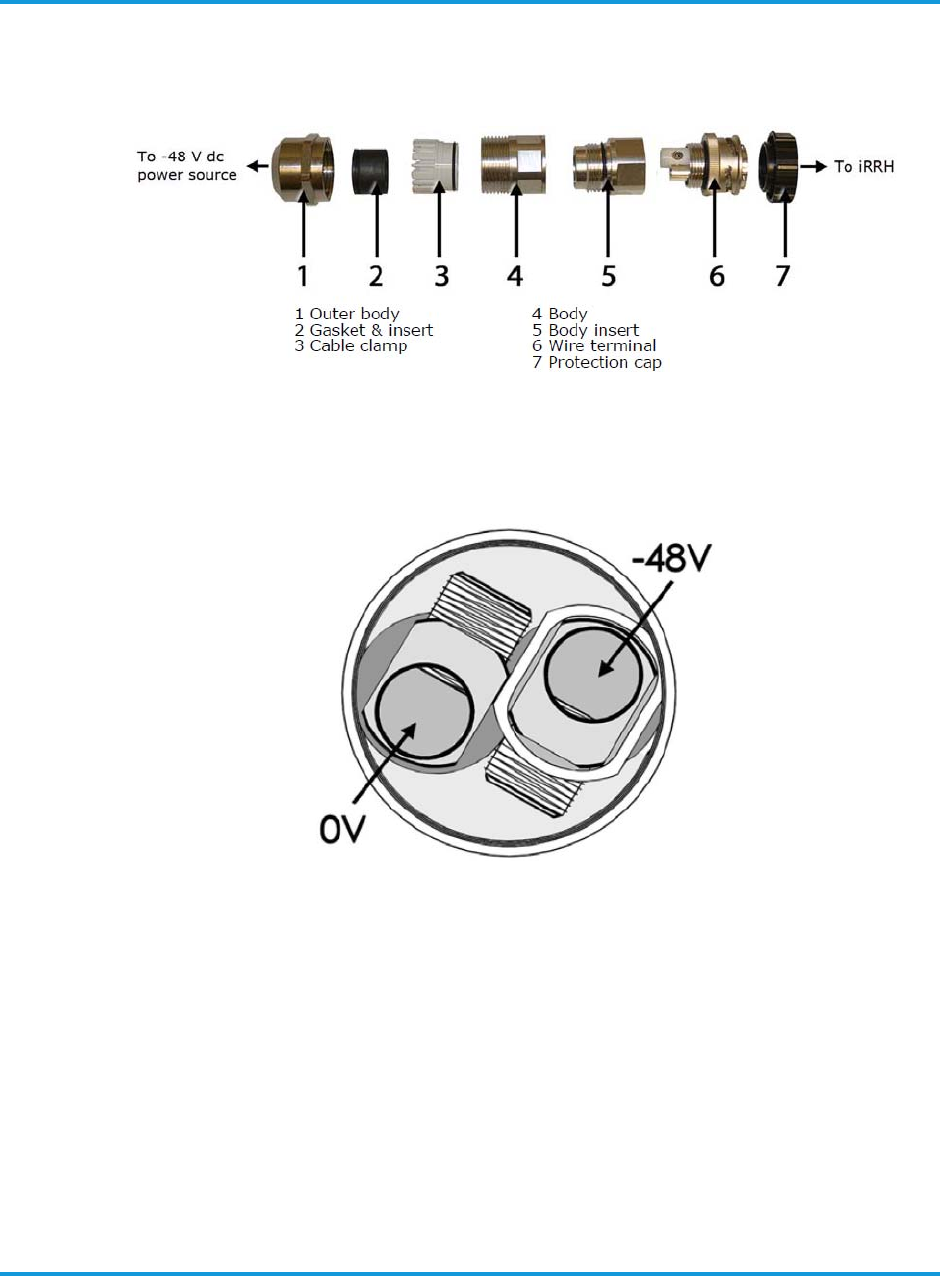
Physical description
iRM4451nn00-2 iRRH Product Description and Installation Guide 3-7
cable onto the plug. Assembly instructions (MA_99A5) are found in the kit with the
mating plug.
Figure 3-7 Rosenberger –48 V DC power plug (exploded view)
The power source end of the plug has screw terminals for connection to Installer-
provided 8 AWG power cables. Power cable connection at the source end of the
power cable is shown in Figure 3-8.
Figure 3-8 Cable connection for supplied 2-pin Rosenberger plug
The mating plug is fastened by turning the coupling nut clockwise 1/4 turn by
hand until it 'clicks' into the locked position. To remove the power plug, twist the
coupling nut counter-clockwise 1/4 turn.
The Installer must assemble the cable on site in a length ordered according to the
site requirement. Use cable type SOOW, 8 AWG (min.), 2-conductor (8/2),
shielded, stranded copper wires, indoor/outdoor, round cable, cable
OD 0.28–0.67 in (7–17 m), rated at 600 V, or equivalent. Cable can be a
maximum of 328 ft (100 m) in length. The Installer is responsible for determining
the power interface requirements at the supply-side of the cable and orders and
installs the required connector, if any.

Physical description
3-8 iRM4451nn00-2 iRRH Product Description and Installation Guide
3.2.4 RET connector
The RET (Remote Electrical Tilt) bulkhead connector provides the capability of
electrical antenna control to all antennas connected to the iRM4451nn00-2. Pin
assignments for the RET standard 8-pin DIN connector is shown in Figure 3-9.
The connector is keyed to prevent mis-mating. The connector is fastened by
turning the coupling nut clockwise until hand tight..
Figure 3-9 RET standard 8-pin DIN connector
The RET cable and connectors is a standardized AISG RET Control Cable available
from many vendors. Installer supplies and installs RET cables in lengths according
to site requirements.
The RET cable can be daisy-chained to other antennas served by the
iRM4451nn00-2 iRRH if the option is provided by the RET motor manufacturer.
Antenna RET control is facilitated within the EMS user interface.
The Installer is responsible for providing and pre-assembly of the standardized
RET cable and connector in a length according to site requirements.
3.2.5 Fronthaul connectors
Two Gigabit Ethernet (GigE) optical SFP fronthaul ports provide connection for up
to two duplex multi-/single-mode optical GigE cables. The GigE entry ports,
labeled FH1 and FH2, are located on the bottom of the iRM4451nn00-2 iRRH (see
Figure 3-4). Connector FH1 is intended for fronthaul support. FH2 is used to daisy-
chain sidehaul support to up to one other iRM4451nn00-2.
The macro iRRH is shipped with Rosenberger Fiber Enclosure (RFE) flange (PN
98Z405-K00)—a bulkhead connector with captive dust cover—installed. The mate
to the flange is the RFE ‘plug’ (Rosenberger PN 98Z105-S00) which contain the
two duplex optical GigE fiber cables and protects the fiber connections. One (1)
RFE plug is provided with the macro iRRH. They are UL94-V0 and IP67 compliant
at–40° to 158° F (–40° to 70° C).
1 NC
2 NC
3 RS5
4 NC
5 RS5 A
6 +24 V DC
7 Dc return
8 NC
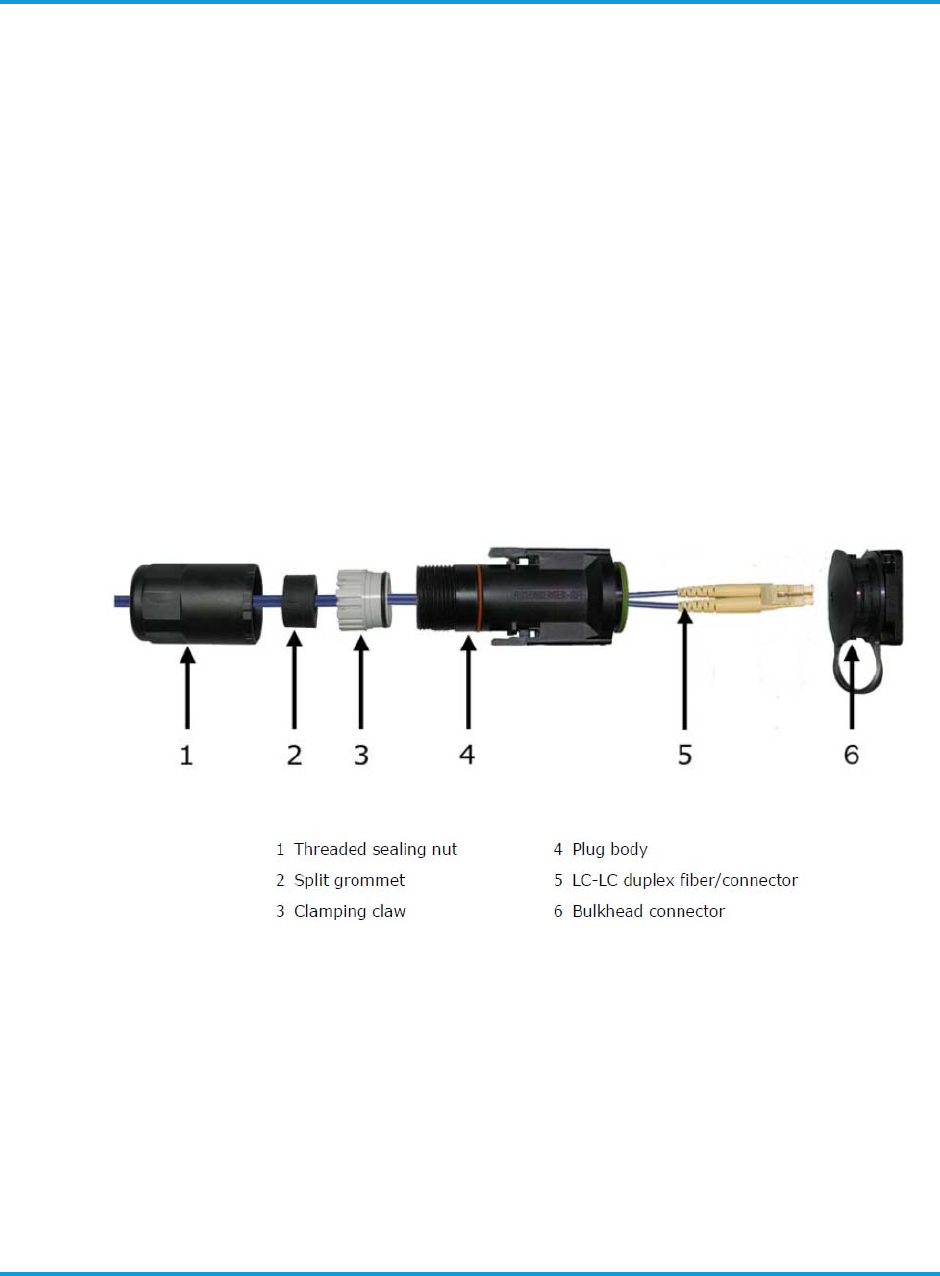
Physical description
iRM4451nn00-2 iRRH Product Description and Installation Guide 3-9
To assemble the Rosenberger RFE plug, the threaded sealing nut is first routed
onto the fiber cable, followed by installation of a split grommet and clamping claw
onto the fiber itself (see Figure 3-10 for the order of RFE assembly). The fiber
cable/split grommet/clamping claw assembly is then pressed and seated into the
plug body. Approximately 3–5 in (76–127 mm) of fiber cable, including the duplex
fiber plug, should extend beyond the outside after the RFE ‘plug’ assembly is
assembled.
The RFE plug is assembled by screwing the threaded sealing nut clockwise until it
seats into position, hand tight, on the plug body. This completes the assembly of
the RFE plug. The fiber connector is then inserted into the SFP fiber module, which
is recessed in the iRRH fronthaul port, until it ‘clicks’ into position. Any slack fiber
cable is stored inside the RFE plug. The RFE alignment rails on the RFE plug are
engaged now with the bulkhead connector. When pushed in firmly, it ‘clicks’ into
place and is locked onto the bulkhead connector completing the installation. The
RFE cannot be removed because the latch function has been disabled by the
obstruction at the latch pivot when seating the threaded sealing nut.
To remove the RFE plug from the bulkhead connector, the plug housing must be
turned counter-clockwise until obstruction of the release latches on either side of
the plug body, has been cleared. Finally, pressing on both latches at the same
time and pulling the plug body removes the RFE from the bulkhead connector.
Figure 3-10 Rosenberger RFE fiber-optic enclosure
The dust covers over the FH1 and FH2 flanges should remain in place until the
GigE optical Ethernet cables are connected and on any unused port. The dust
covers are keyed to ensure proper installation. To remove the dust cover, just pull
it off. The dust covers are re-installed in the opposite manner.
The recommended GigE fiber optic cable (x2) is OM1 62.5/125, military fiber
cable, with dual LC/dual LC termination and is provided by L-Com (FODLCMIL-nn,
or equivalent, where nn = length in meters). The Installer is responsible for
ordering this cable in the appropriate length according to site requirements.
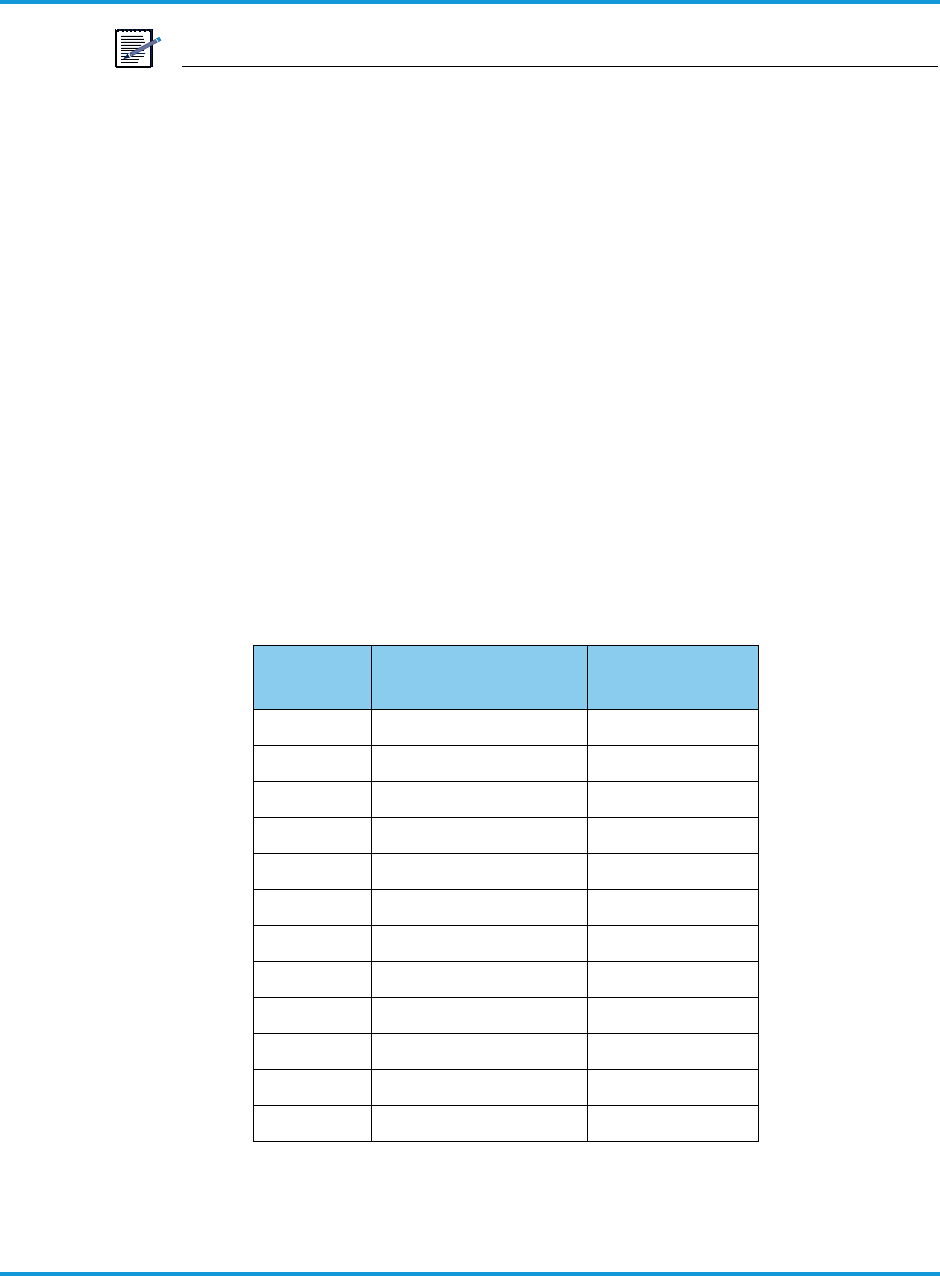
Physical description
3-10 iRM4451nn00-2 iRRH Product Description and Installation Guide
NOTE
Remove the dust cap only when ready to connect the cable to the
iRM4451nn00-2.
The GigE optical fronthaul cables are supplied and pre-installed at the site by the
Installer. Detailed assembly instructions (Rosenberger PN MA_98A1) are supplied with
each Rosenberger RFE in its packing box.
3.2.6 Alarms connector
There is a panel-mount plug connector (ALARMS) located on the side of the
iRM4451nn00-2 for aggregating alarms from equipment near the macro iRRH. It is
a Lumberg 03 series 12-pin screw-lock circular DIN connector.
The alarms cable receptacle (plug) is provided as a kit. It includes a Lumberg
circular DIN connector (part no. 0322 12) with 12-contacts, and is iP68 and RoHS
compliant. It is keyed to prevent mis-mating.
The compatible alarms cable must be a 4-pair, 23–24 AWG (0.26–0.20 mm2) with
cable OD 4–8 mm, shielded, ruggedized, oil resistant, and outdoor rated at –40°
to 131° F (–40° to 55° C), or equivalent. Connector pin assignments are shown in
Table 3-3.
Table 3-3 Lumberg 0315 12 alarm connector details
The Installer is responsible for supplying the cable and cable pre-assembly,
including defining the wire-color matched to pin assignments for the plug
assembly. The final wire-color pin assignments are recorded into the site log.
Pin
number Pin
assignment Function
1Pin A NA
2Pin B NA
3Pin C NA
4Pin D NA
5Pin E Alarm1-A
6Pin F Alarm1-B
7Pin G Alarm2-A
8Pin H Alarm2-B
9Pin J Alarm3-A
10 Pin K Alarm3-B
11 Pin L Alarm4-A
12 Pin M Alarm4-B
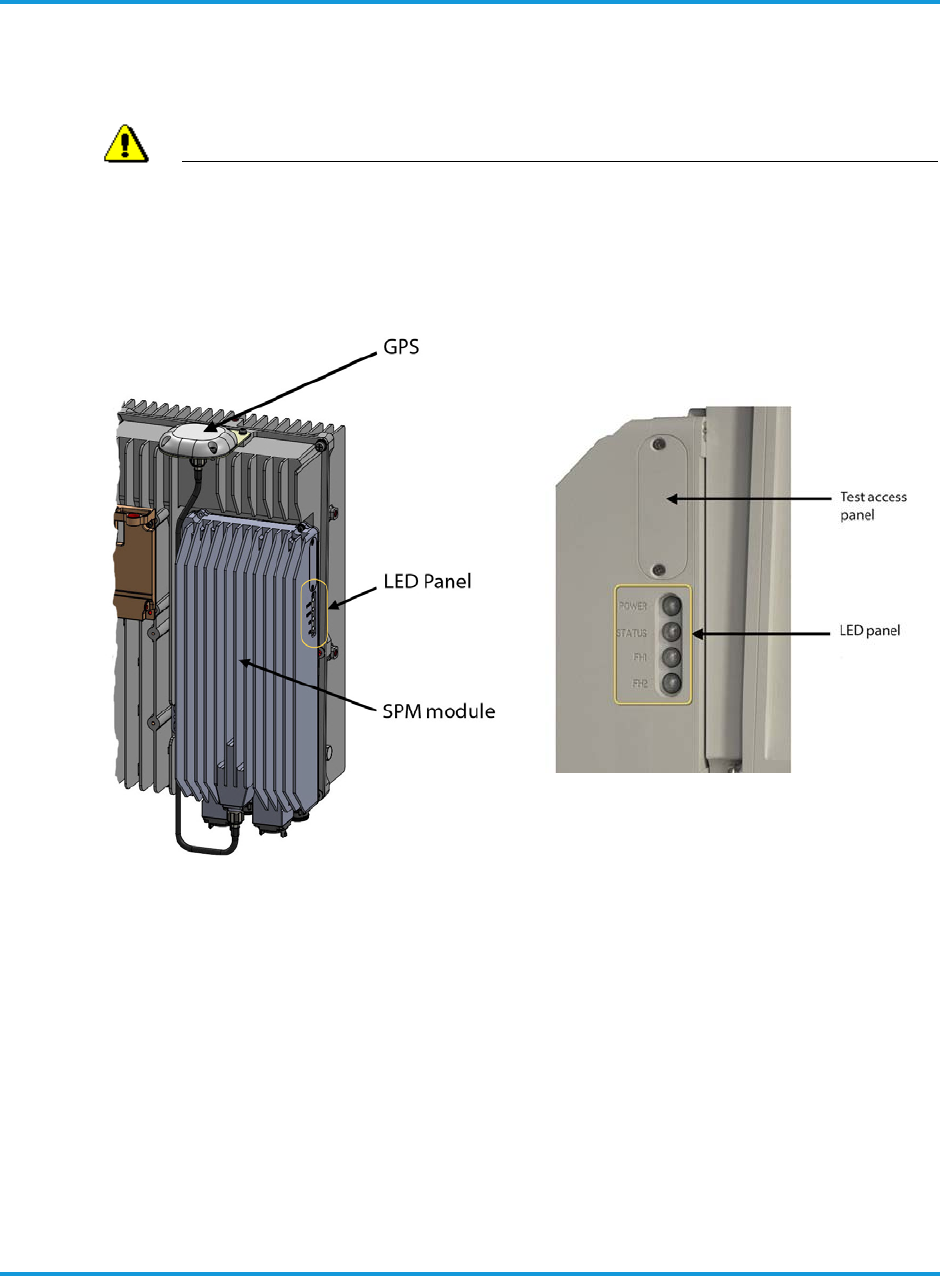
Physical description
iRM4451nn00-2 iRRH Product Description and Installation Guide 3-11
3.2.7 Access panel (factory use only)
An access panel (Figure 3-11)is located on the SPM module next to the LEDs. This
panel is for factory use only.
WARNING
DO NOT OPEN THE ACCESS PANEL. The access panel is for factory use
only. Opening the access panel will compromise the integrity of the
weather-tight seal and void the warranty.
Figure 3-11 iRM4451nn00-2 SPM module, Test Access Panel and LED panel
3.2.8 LED indicators
There are four LED indicators located on the right side of the iRM4451nn00-2 iRRH
as shown in Figure 3-11. Each LED can be either off, green, amber or red. The
description and operating characteristics of each LED is described in Table 3-4.
The blink rates for the LEDs are described in Table 3-5. Table 3-6 describes the
LED lighting sequence during boot-up.

Physical description
3-12 iRM4451nn00-2 iRRH Product Description and Installation Guide
Table 3-4 LED indicators description and operating characteristics
Indicator Description Operation
POWER Indicated power ON/OFF status
• OFF when no power is applied to the unit
• Steady GREEN when power to the unit is
normal/in service
• Steady RED when a power fault is present
STATUS Indicates the status of the
iRM4451nn00-2
• OFF when no power is applied to the unit
• Steady GREEN when GPS or 1588V2 timing
synchronization lock is achieved
• Slow GREEN blink when booting up or
shutting down
• Steady AMBER when minor fault occurs
(hardware or software)
• Steady RED when a critical or major fault
occurs (hardware or software)
FH1
Indicates the status of the
Ethernet fronthaul data Port 1
throughput
• OFF when no power is applied to the unit or
when booting
• Steady GREEN when port has link and
operating at Gigabit Ethernet rate, but there
is no Ethernet activity
• Slow GREEN when port is operating at
Gigabit Ethernet rate and has Ethernet
activity
• Steady AMBER when less than Gigabit
Ethernet mode
• RED when a critical fault occurs
FH2 Indicates the status of the
Ethernet fronthaul data Port 2
throughput
Future use
*Refer to LED callouts in Figure 3-11.
Table 3-5 LED blink rates
Indicator state Description
Steady OFF LED OFF
Steady ON LED is continuously ON, no interruption
Slow blink LED ON for about 0.5 s and OFF for about 0.5 s
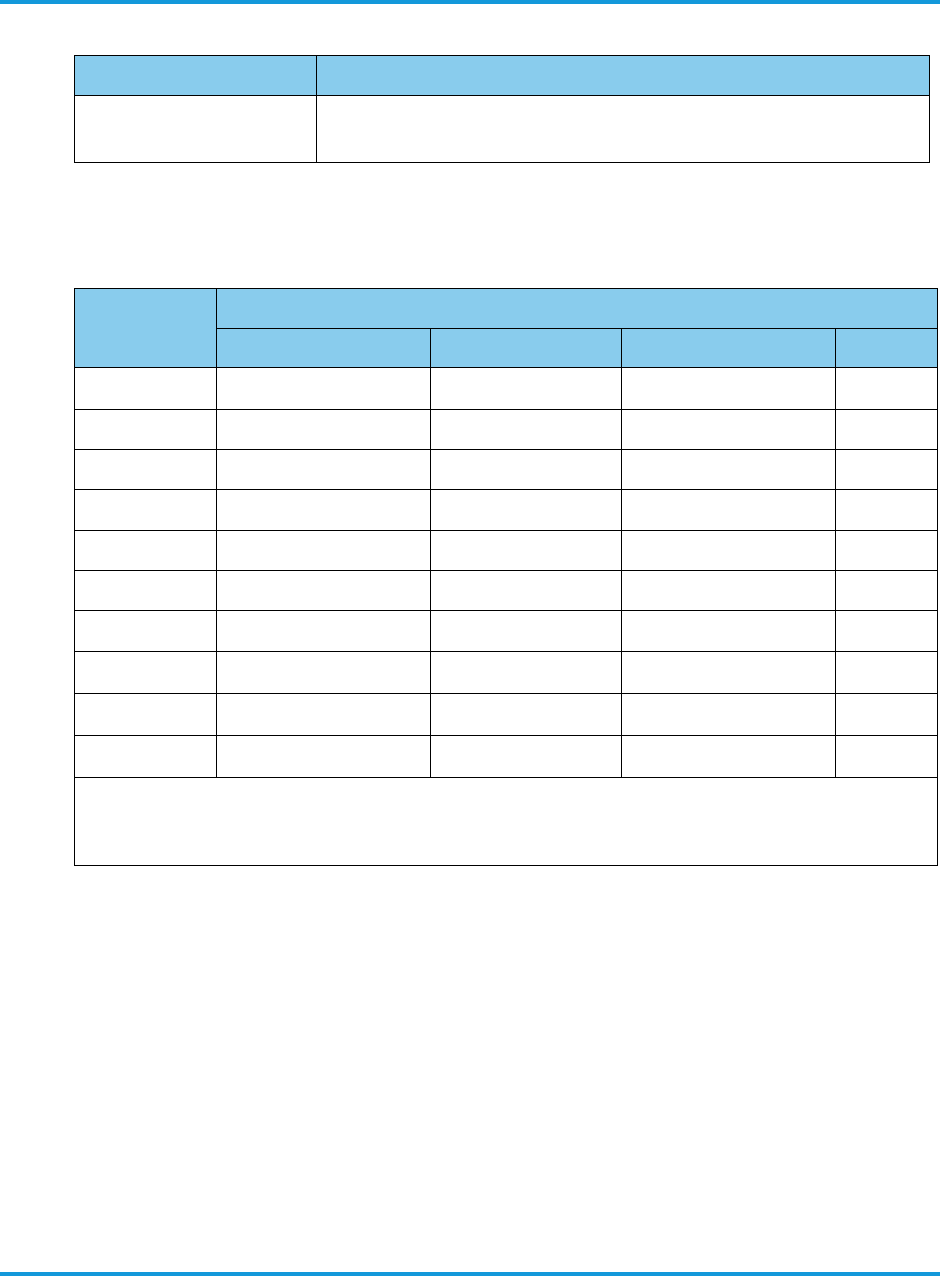
Physical description
iRM4451nn00-2 iRRH Product Description and Installation Guide 3-13
3.2.9 Vent port
A gas permeable vent has been installed on the iRM4451nn00-2 iRRH to help
equalize air pressure inside the enclosure and prevent contaminants such as
water, salt and dust from getting inside (see Figure 3-12). The vent fitting has a
gas-permeable membrane integrated into a screw-in fitting. It meets the IEC
60529 standard for enclosure ingress protection against particulates and liquids.
The vent should function maintenance-free over the lifetime of the
iRM4451nn00-2.
Fast blink Varying blink rate, noticeably faster than a slow blink rate (used only as a
location aid/unit ID)
Table 3-5 LED blink rates
Indicator state Description
Table 3-6 LED indicators boot-up sequence
Time (mm:ss) Indicator name
POWER STATUS FH1 FH2
—OFF OFF OFF
OFF
00:01 Fast blink OFF OFF OFF
00:02 Steady ON Green OFF OFF OFF
00:03 Steady ON Red OFF OFF OFF
00:04 OFF OFF OFF OFF
00:10 Fast blink OFF OFF OFF
00:11 Steady ON green OFF OFF OFF
00:16 * OFF Slow/Fast flash green OFF
00:60 * Slow flash green Slow/Fast flash green OFF
02:30 Steady ON green Steady ON green Slow/Fast flash green OFF
NOTE: Assumes FH1 is connected and FH2 is not connected. Initial state (—) is power OFF. * means
state remains as previously indicated. GPS lock is achieved at 02:30 as indicated by STATUS LED being
Steady On green.
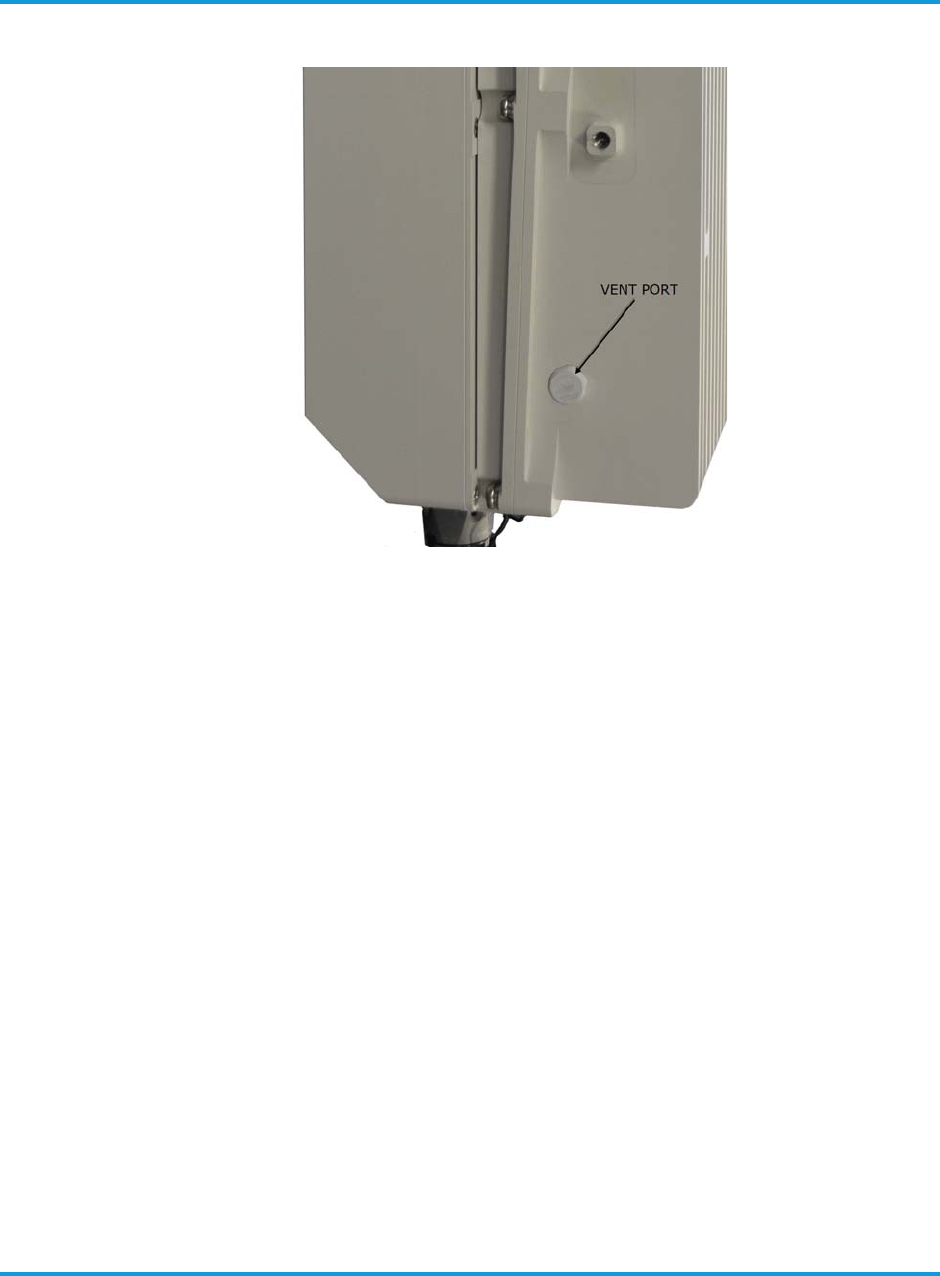
Physical description
3-14 iRM4451nn00-2 iRRH Product Description and Installation Guide
Figure 3-12 Vent port
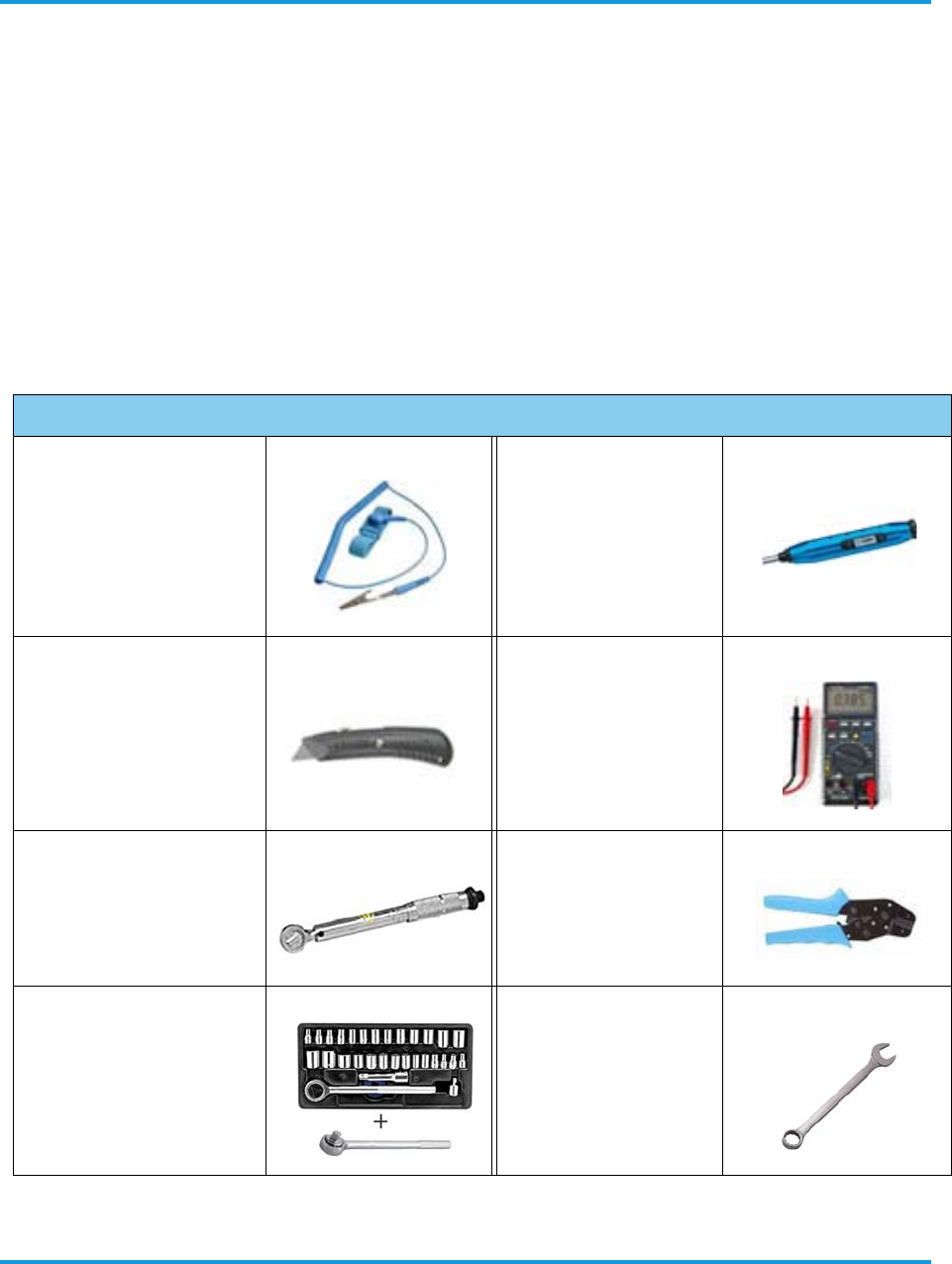
Installation prerequisites
iRM4451nn00-2 iRRH Product Description and Installation Guide 4-1
4 Installation prerequisites
This section contains information on the documentation, tools, equipment, and
conditions required for performing the installation procedure. The document assumes
that the target audience has reasonable industry experience, is qualified, and has
installed wireless base stations in the past.
4.1 Required tools
A typical telecommunications technician's toolkit is required to complete the
iRM4451nn00-2 installation. Additional required specialty tools and consumables are
listed in Table 4-1.
Table 4-1 Required tools
Required Tools
ESD wrist grounding
strap
Torque screwdriver
and assorted bits
Box cutter Digital voltmeter
Torque wrench, open-
end, 8 mm
Crimp tool (2 to 8
AWG)
Socket set, plus
additional socket
wrench
Wrench, 3/4 in (19
mm)
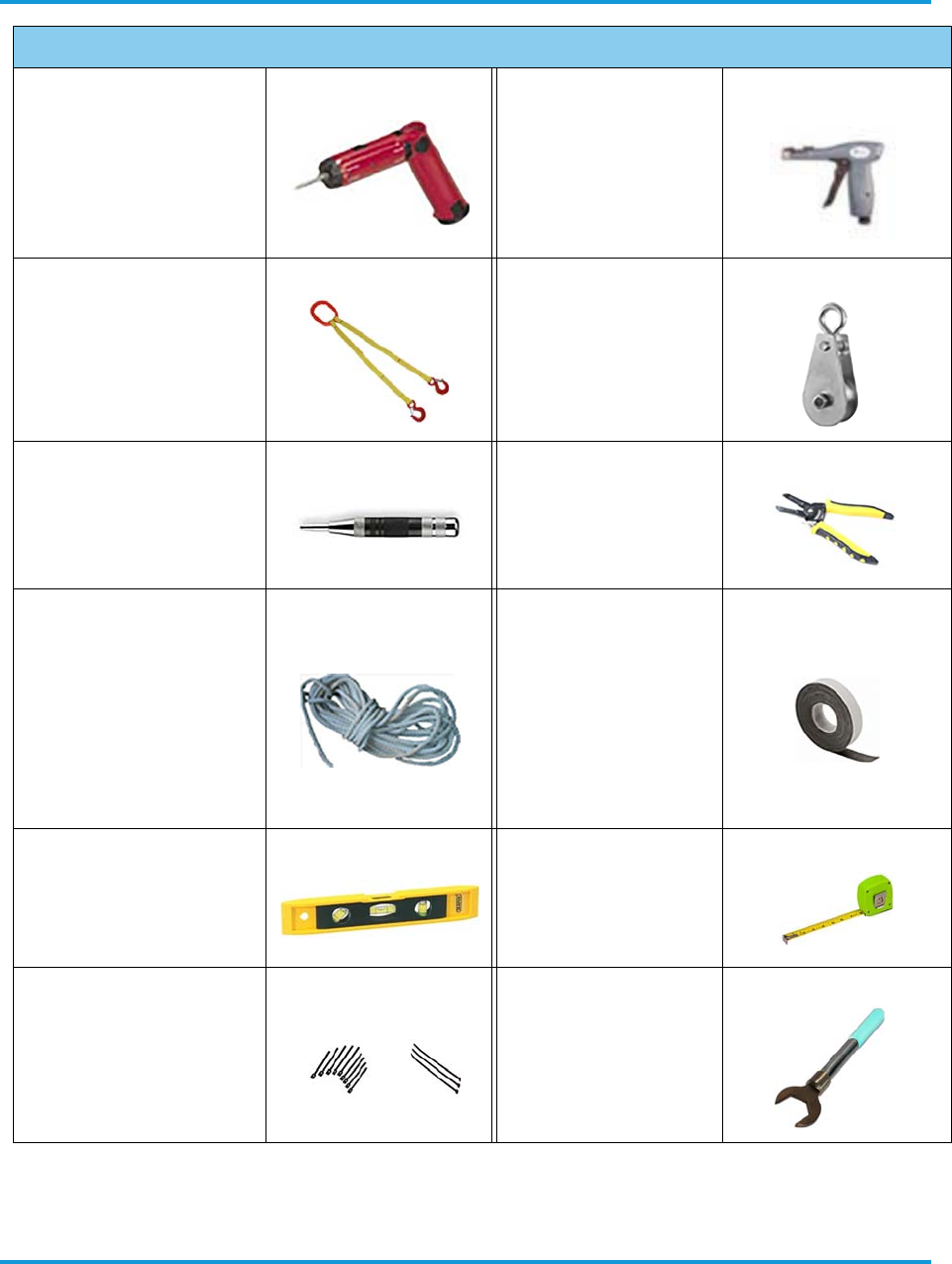
Installation prerequisites
4-2 iRM4451nn00-2 iRRH Product Description and Installation Guide
Cordless electric
screwdriver Cable tie tool
Nylon bridle sling, 2-
leg, 2 in (5.1 mm)
straps, 6×19 EIPS, or
equivalent
Pulley-minimum
load-bearing
capacity 880 lb (400
kg)
Punch Wire stripper
Rope - minimum
breaking strength
600 lb (272 kg)
Self-amalgamating
waterproofing tape
(e.g., Commscope
Miracle Tape,
Huber+Suhner Fast-
Wrap, RFS CELL-
Tape, EasyWrap®
tape, etc.)
Spirit level Tape measure
Assorted hook & loop
fasteners (for fiber
optic cables) and cable
ties (for all other
applications)
Torque wrench for
7/16 conn, 32 mm,
211 in-lb
(25 Nm)
Required Tools

Installation prerequisites
iRM4451nn00-2 iRRH Product Description and Installation Guide 4-3
4.2 Required site equipment
This section describes the additional interconnecting equipment required for the
installation of the Altiostar Networks iRM4451nn00-2. These are essentially cables,
connectors and fixing arrangements. The specification of these items may need to be
customized on site by the Installer (specifically the type and length of cables). Refer
to Table 3-2 when ordering and customizing the following items:
• Grounding cable between the iRRH and the local grounding point. Altiostar
Networks provides the two-hole lug for crimping onto the cable.
• Power cable between the iRRH and local DC supply. Installer must provide suitable
lightning and surge suppression devices on the power line to the unit (minimum
20 kA-rated device recommended). We recommend one lightning and surge
suppressor be installed close to the iRRH on the tower/pole/wall and one on the
cable entrance just before it enters the facility.
• Optical fiber cables between iRRH and transport network.
Other than lightning and surge suppression devices, Table 4-2 provides a list of the
Installer-supplied interconnection equipment required to install the iRM4451nn00-2.
NOTE
Some parts have an order lead-time of up to 10 weeks. It is important that
these items be ordered as soon as possible in the planning phases of the iRRH
installation so that they are available on-site at the time of installation.
Insulating gloves (for
lifting hot unit)
Hardhat, eye
protection and other
safety apparatus
Eyebolts (McMaster
Model 3040T13, or
equivalent)
M8 ×1.25, 16mm,
quantity 2 (lifting) and
1 (guiding) minimum
1/2-in drive, 3/4 in
(19 mm) extra deep
well sockets, 5 in
(127 mm) min
internal depth.
Quantity 2, for
accessing mounting
bracket M12 bolts.
Required Tools

Installation prerequisites
4-4 iRM4451nn00-2 iRRH Product Description and Installation Guide
Table 4-2 iRM4451nn00-2 iRRH Installer-supplied parts list
4.3 Site preparation
It is a critical that the conditions in this section must be fulfilled before starting work
at the site.
4.4 Site pre-installation visit checklist
To verify site conditions required for the installation of the iRRH are known, a pre-
installation visit, attended by the Operator's representative, the Installer, Altiostar
Networks, and other required parties, must be performed. Tasks required to be
accomplished should include, at a minimum, those listed in Table 4-3.
Qty Part number Part description
Installer-acquired parts for pre-installation requirements
1As specified per site
requirement
Any splitter/combiner/amp/cable required for
shared
remote antenna.
1As specified per site
requirement
Power cable, 8 AWG min., shielded, round cable.
Refer to
Power connector on page 3-6 (Installer orders to
length according to site requirement.)
1
L-Com (part no.
FODLCMIL-nn, or
equivalent)
GigE duplex multi-/single-mode fiber-optic cable,
OM1
62.5/125, military fiber cable, with dual LC/dual LC
terminations, nn = length in meters. For additional
information. Refer to Fronthaul connectors on
page 3-8.
1As specified per site
requirement
AISG RET control cable with 8-pin DIN connector in
required length. Refer to RET connector on
page 3-8.
1 to 2 As specified per site
requirement
4-pr, shielded, outdoor-rated, round alarm cable.
For
additional information, Refer to Alarms connector
on page 3-10.
3
(minimum)
McMaster 3040T13T
(or equiv)
Eyebolt, M8x1.25, 16 mm, SS (third eyebolt to be
used for control line [guide] attachment).

Installation prerequisites
iRM4451nn00-2 iRRH Product Description and Installation Guide 4-5
Table 4-3 Site pre-installation visit checklist
Item Site pre-installation visit checklist Check
1Verify Site Installation Plan and installation documentation is available.
2Verify health and safety documentation specified by the Operator and Altiostar Networks
are understood and installation personnel are trained accordingly.
3Know locations of fire equipment, eyewash stations, and evacuation procedures posted
for fire/halon discharge.
4Know locations of first aid and emergency equipment and installation personnel are
familiar with their operation and use.
5Verify site authorizations, clearances, and releases from Operator and local authorities
are complete.
6Verify emergency telephone numbers are posted for fire, police, and ambulance/medical
aid.
7Verify contact information for the Operator or his representative(s), the Installer, and
local authorities are posted.
8Verify installation schedule is approved.
9Wear approved protective equipment such as hard hats, safety glasses, gloves, etc.
when needed.
10 Verify the installation location of the iRRH meets the mounting requirements indicated in
this document.
11 Verify main power supply is properly installed and tested and capable of supplying the
required voltage (–55.2 £ –48.0 £ –43.2 V DC) and current for proper operation of the
iRRH.
12 Verify –48 V DC power cable to the iRRH is labeled and tested as specified in the Site
Installation Plan.
13 Verify recommended size breakers/fuses for the external power source is properly
installed and capable of protecting the –48 V DC power to the unit.
14 Verify earth ground bonding point, for connection of the grounding cable to the iRRH is
correctly installed, labeled and tested as specified in the Site Installation Plan.
15 Determine a safe method to hoist and secure iRRH into position on selected structure
and enter into Site Installation Plan.
16 Verify proper in-line surge protectors are installed, where required, on power and RET
cables as specified in the Site Installation Plan.
17 Verify that the Operator, Installer, Altiostar Networks and all other affected parties are in
agreement with the equipment installation location, power source, and grounding
location, to meet the installation checklist requirements.

Installation prerequisites
4-6 iRM4451nn00-2 iRRH Product Description and Installation Guide
4.5 Site installation checklist
Verify site conditions required for the installation of the iRRH are known. In addition,
the site must be prepared by the Installer in accordance with the Site Installation
Guide provided by the Operator which must include, at a minimum, the required tasks
in Table 4-4. The Installer or his representative should initial and date the Check box
as each item is completed.
Table 4-4 Site installation checklist
Item Site installation checklist Check
1 Verify Site Installation Plan and installation documentation is available.
2
Verify health and safety documentation specified by the Operator and
Altiostar Networks are understood and installation personnel are trained
accordingly.
3Know locations of fire equipment, eyewash stations, and evacuation
procedures posted for fire/halon discharge.
4Know locations of first aid and emergency equipment and installation
personnel are familiar with their operation and use.
5Verify site authorizations, clearances, and releases from Operator and local
authorities are complete.
6Verify emergency telephone numbers are posted for fire, police, and
ambulance/medical aid.
7Verify Operator or his representative(s), the Installer, and local authorities
contact and phone numbers are posted.
8 Verify installation schedule is approved.
9Wear approved protective equipment such as hard hats, safety glasses,
gloves, etc. when needed.
10 Verify pre-installation work specified in the Site Installation Plan is
complete.
11 Verify the installation location of the iRRH meets the mounting requirements
indicated in this document.
12 Verify all required tools required for lifting the iRRH onto structure, and for
installation, are available.
13 Verify all ordered hardware, including that not provided as part of the
Altiostar Networks intelligent eNodeB solution, is available and on site.
14
Verify that the Operator or his representative(s), the Installer,
Altiostar Networks, and all other affected parties are in agreement
with the equipment installation location, power source, and
grounding location, to meet the installation checklist requirements.

Installation prerequisites
iRM4451nn00-2 iRRH Product Description and Installation Guide 4-7
15
Verify proper in-line surge protectors are installed, where required,
on –48 V DC power and RET cables as specified in the Site
Installation Plan.
16 Verify recommended size wire is installed in the external power
source supplying –48 V DC power to the unit.
17
Verify custom pre-assembled cables, custom cables, wires and other
material are properly labeled, installed and tested according to
system and site requirements as specified in the Site Installation
Plan.
18 Verify earth grounding of the chassis/rack hosting the iRRH is
correctly installed, using the correct size/type wire, and is tested.
19
Verify main power supply is properly installed and tested and
capable of supplying the required voltage (–55.2 £ –48.0 £ –
43.2 V DC), and current for proper operation of the iRRH.
20
Verify all cables are neatly routed through cable ladders, cable trays
and ducts, are secured with cable ties/wraps, and dressed according
to local practice.
Table 4-4 Site installation checklist
Item Site installation checklist Check

Installation prerequisites
4-8 iRM4451nn00-2 iRRH Product Description and Installation Guide

Installation overview
iRM4451nn00-2 iRRH Product Description and Installation Guide 5-1
5 Installation overview
This section provides an overview of the installation procedures and instructions for
installing the Altiostar Networks iRM4451nn00-2 intelligent Remote Radio Head.
All required cabling for grounding, power, fronthaul, RF and optional GPS, are supplied
by the Installer, as provided in the Site Installation Plan, and should already be pre-
installed with drops to the iRRH location, or according to local practice.
5.1 Installation procedures
The following list describes the top-level iRM4451nn00-2 installation procedures. You can
instantly navigate to any procedure by clicking on the procedure with the mouse.
•Unpacking the shipping container on page 5-1
•Verifying all parts received on page 5-2
•Assembling cables on page 6-1
•Verify Installer-supplied –48 V dc power cable on page 6-1
•Verify Installer-supplied GigE optical cable on page 6-1
•Verify Installer-supplied grounding cable on page 6-1
•Routing pre-assembled power/GigE optical fronthaul/grounding cables on
page 6-2
•Mounting on a pole/mast on page 6-4
•Mounting on a wall on page 6-5
•Hoisting the iRM4451nn00-2 on elevated structures on page 6-6
•Installing the iRM4451nn00-2 on the mounting bracket on page 6-7
•Connecting the grounding cable on page 6-8
•Connecting the RET cables on page 6-9
•Connecting the GigE optical fronthaul cables on page 6-10
•Connecting the RF cables on page 6-10
•Connecting the alarms cable on page 6-11
•Connecting the –48 V dc power cable on page 6-11
•Weatherproofing cable connections on page 6-11
•Checking power on page 6-12
5.2 Unpacking the shipping container
The following procedure describes removing the iRRH from the shipping container,
inspecting the contents for damage, and what to do if damage is found.
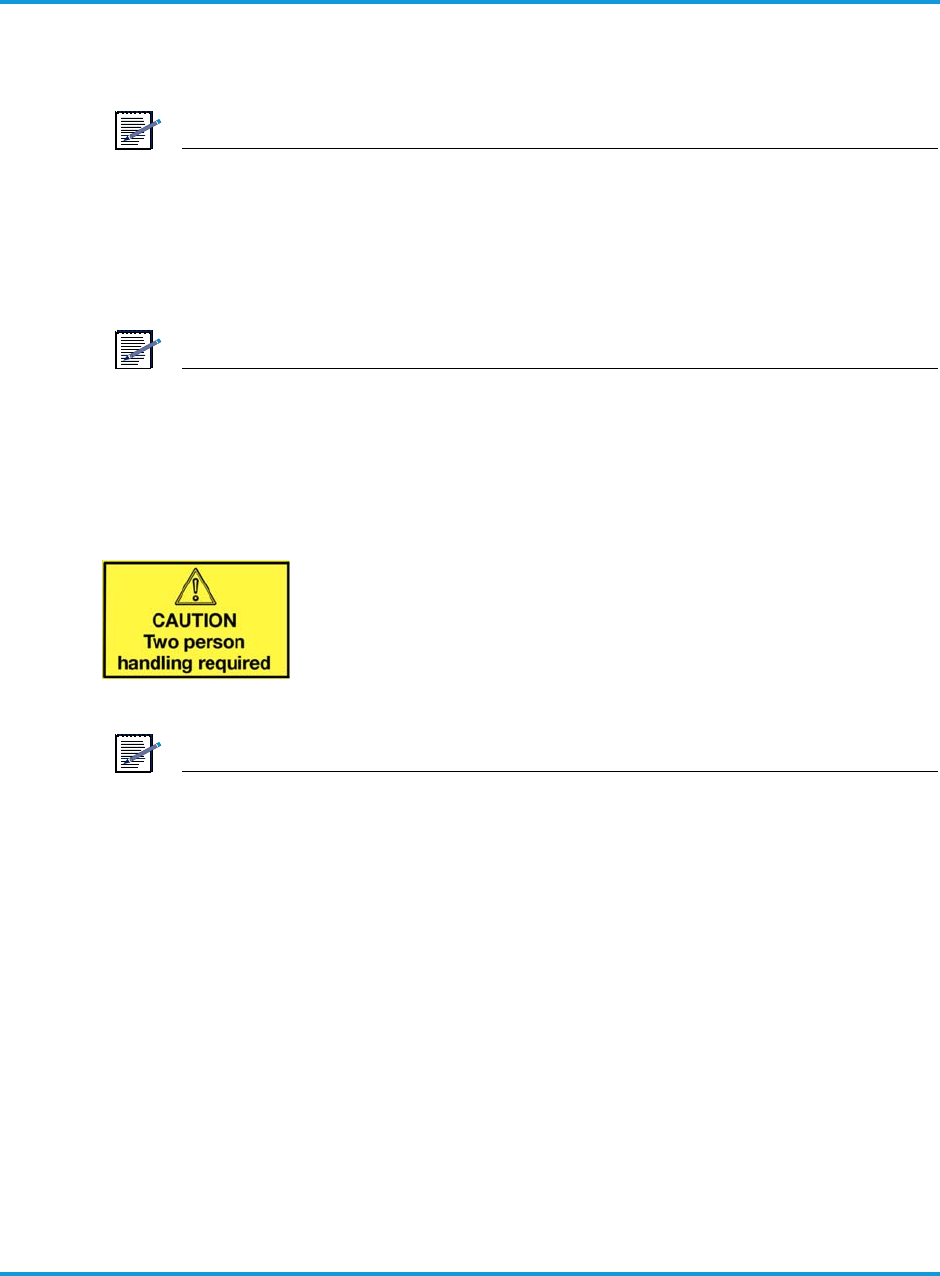
Installation overview
5-2 iRM4451nn00-2 iRRH Product Description and Installation Guide
To unpack the shipping container:
1. Verify no shipping damage to box.
NOTE
It is important to report damage or material shortages to the shipping carrier
while a representative is on site. If concealed damage or material shortages are
found at a later time, contact the shipper to make arrangements for inspection
and claim filing.
2. Remove packing materials.
NOTE
The shipping materials can be recycled. In some regions or countries it is
mandatory that packing materials be recycled or re-purposed. Please dispose of
shipping material accordingly.
3. Remove equipment from packing material and inspect equipment for shipping
damage or missing items.
NOTE
If concealed damage or material shortages are found at a later time, contact the
shipper to make arrangements for inspection and claim filing.
5.3 Verifying all parts received
Verify all parts listed in the accessory list in Table 5-5 were received.
Assisted carry ONLY! This object is heavy; over 75 lb. (34.0
kg). Follow instructions when lifting unit from shipping container
and hoisting onto mounting bracket. Requires a minimum of two
people to lift and hand carry the unit.
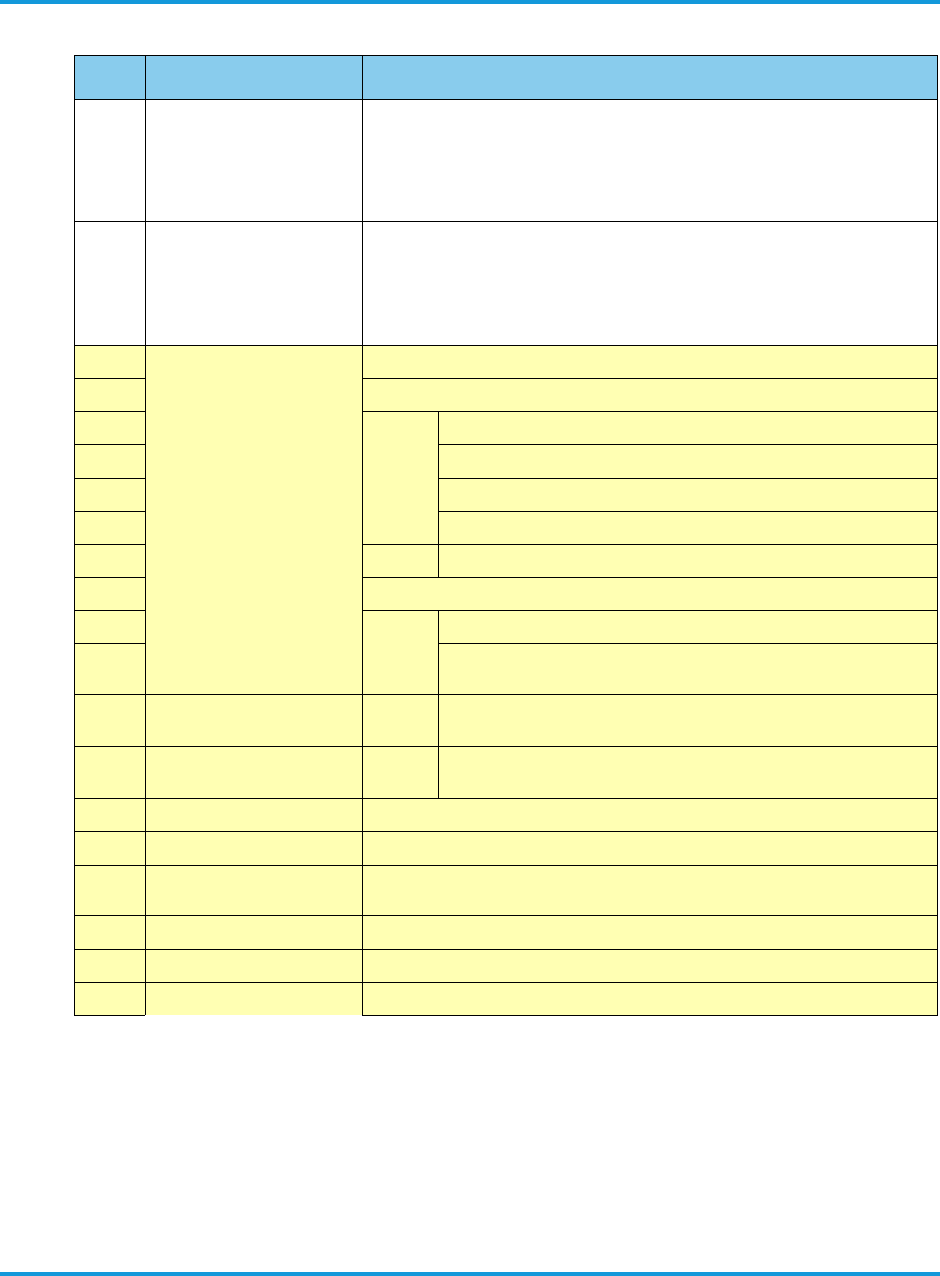
Installation overview
iRM4451nn00-2 iRRH Product Description and Installation Guide 5-3
Table 5-5 iRM4451nn00-2 iRRH parts list
Qty Altiostar part number Part description
1509-0n-0002
(top level)
n = 2 Band 7 (2.6 GHz)
n = 3 Band 4 (AWS)
n = 4 66A (AWS & AWS-3)
n = 5 Band 2 (1.9 GHz)
n = 6 Band 3 (1.8 GHz)
1
n=2 340-00-0068
n=3 340-00-0067
n=4 340-00-0066
n=5 340-00-0070
n=6 340-00-0069
iRM4451nn00-2 macrocell (main unit) assy., 4T4R
1350-00-0033
350-00-0007
Kit, accessory, iRRH chassis—2 sub-kits
Sub-kit #1: Standard mounting bracket hardware, outdoor
2 460-00-0014 Screw, M4-0.7 × 12 mm, cross-head pan, SEMS, SS
2460-00-0020 Screw stud, M12-1.75 × 168 mm, SS
4495-00-0001 Washer, flat, M12, max. 24 mm OD, SS
4495-00-0002 Washer, split, M12, max. 21.1 mm OD, SS
4445-00-0003Nut, M12-1.75, SS
350-00-0009 Sub-kit #2: Accessory, grounding cable lug
1440-00-0033 Dual-hole grounding lug, 6 AWG, CAT10-5POI
3460-00-0017 Screw, crosshead pan, M5-0.8 × 10 mm, split/plain
washer, SEMS, SS
1100-00-0213 DC power connector, EMI shielded 2-way cable plug,
Rosenberger 99S73B-199N1
1100-00-0222 Connector, fiber enclosure for fronthaul, fits 4.5–9.0 mm
cable, Rosenberger 98Z105-S00
1350-00-0037 Kit, GPS antenna
3460-00-0012 Fasteners, mounting bracket
1 195-00-0087 Antenna, GPS, w/ 2 ft (0.6 m) pigtail terminating in Type
N-male connector (to SPM GPS connector)
1430-00-0032 Mounting bracket, GPS
1420-00-0030 Mounting clamp, universal (metal, powder-coated)
1420-00-0109 Mounting bracket, universal (metal, powder-coated)

Installation overview
5-4 iRM4451nn00-2 iRRH Product Description and Installation Guide

Installing the iRM4451nn00-2
iRM4451nn00-2 iRRH Product Description and Installation Guide 6-1
6 Installing the iRM4451nn00-2
This section provides the procedure for installing the iRM4451nn00-2 iRRH in remote
locations such as on towers, poles, masts, walls, roofs, or other structures utilizing a
universal mounting assembly.
Instructions for making connections to external interfaces, cabling, grounding and
power are also provided.
6.1 Assembling cables
The Installer will need to order, pre-assemble, and pre-install various cables to the
iRM4451nn00-2. Refer to Required site equipment on page 4-3.
6.1.1 Verify Installer-supplied –48 V dc power cable
The Installer supplies and pre-assembles the –48 V dc power connection cable
according to site requirement. Use an 8 AWG minimum, round, 2-wire with ground,
shielded cable rated at 600 V minimum, or equivalent. The maximum recommended
power cable length is 328 ft (100 m).
The female plug (Rosenberger PN 99S73B-199N1) for assembly of the dc power
cable, is provided with the macro iRRH (see Figure 3-7). The connection configuration
for the supply side of the power cable is determined by site specific requirements.
Assembly instructions are in the packing box with the plug.
6.1.2 Verify Installer-supplied GigE optical cable
The recommended GigE fiber optic cable is OM1 62.5/125, military fiber cable, with
dual LC/dual LC termination (L-Com PN FODLCMIL-nn, or equivalent, where nn =
length in meters). The Installer is responsible for ordering this cable in the
appropriate length according to site requirements.
One (1) RFE plug (Rosenberger PN 98Z105-S00) is provided with the macro iRRH.
The fiber-optic cable and dual mode fiber connector is housed inside the RFE plug.
The RFE plug is essentially a shroud covering the connected fiber-optic connector and
SFP optical module inside the bulkhead on the bottom of the iRM4451nn00-2 to
conform to an IP67 standard, completing the weatherproof seal.
Once assembled, the duplex optical fiber connector is plugged into the optical
connector, then the RFE plug is pushed firmly into the fronthaul port flange on the
bottom of the iRM4451nn00-2 until an audible ‘click’ is heard indicating the plug is
locked into position.
6.1.3 Verify Installer-supplied grounding cable
The grounding cable and ground bonding hardware is supplied by the Installer. The
Installer pre-assembles the grounding cable prior to routing to the iRM4451nn00-2.
However, the grounding terminal lug is supplied with the iRM4451nn00-2.
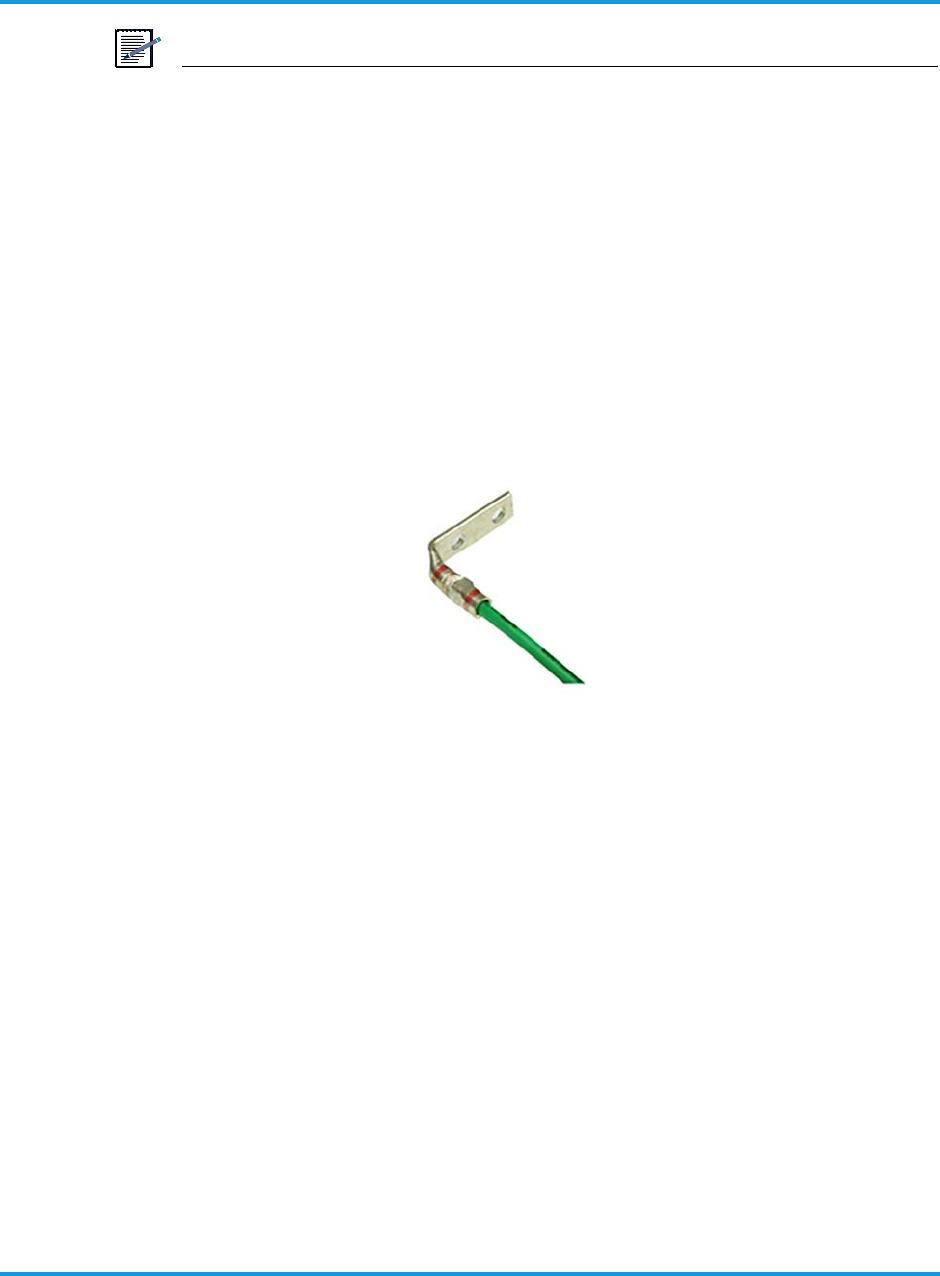
Installing the iRM4451nn00-2
6-2 iRM4451nn00-2 iRRH Product Description and Installation Guide
NOTE
The grounding cable to the iRM4451nn00-2 should be 3.9 in (10 cm) longer
than other cables to the unit. This will maintain ground connection should the
cables be pulled off when the unit is extended beyond the length of the cables.
To install ground terminal lug:
1. Cut a 6 AWG (4.11 mm) stranded grounding cable the appropriate length for the
iRM4451nn00-2 installation.
2. Strip away insulation from one end to expose 3/4 in (19 mm) of bare wire.
3. Crimp the dual-lug grounding terminal (supplied) to the cable using the special-
purpose crimp tool specified in Required tools on page 4-1as directed by tool
manufacturer instruction manual. Figure 6-1 shows an assembled cable/lug
assembly.
Figure 6-1 Grounding terminal lug assembled on grounding cable
6.2 Routing pre-assembled power/GigE optical fronthaul/grounding
cables
This procedures provides instructions for routing the pre-assembled –48 V dc power
cable, the GigE optical fronthaul cable, and the grounding cable to the
iRM4451nn00-2 mounting location before assembling components.
To route cables:
1. Route the cables from the iRM4451nn00-2 installation location to cable sources as
shown in Figure 6-2.
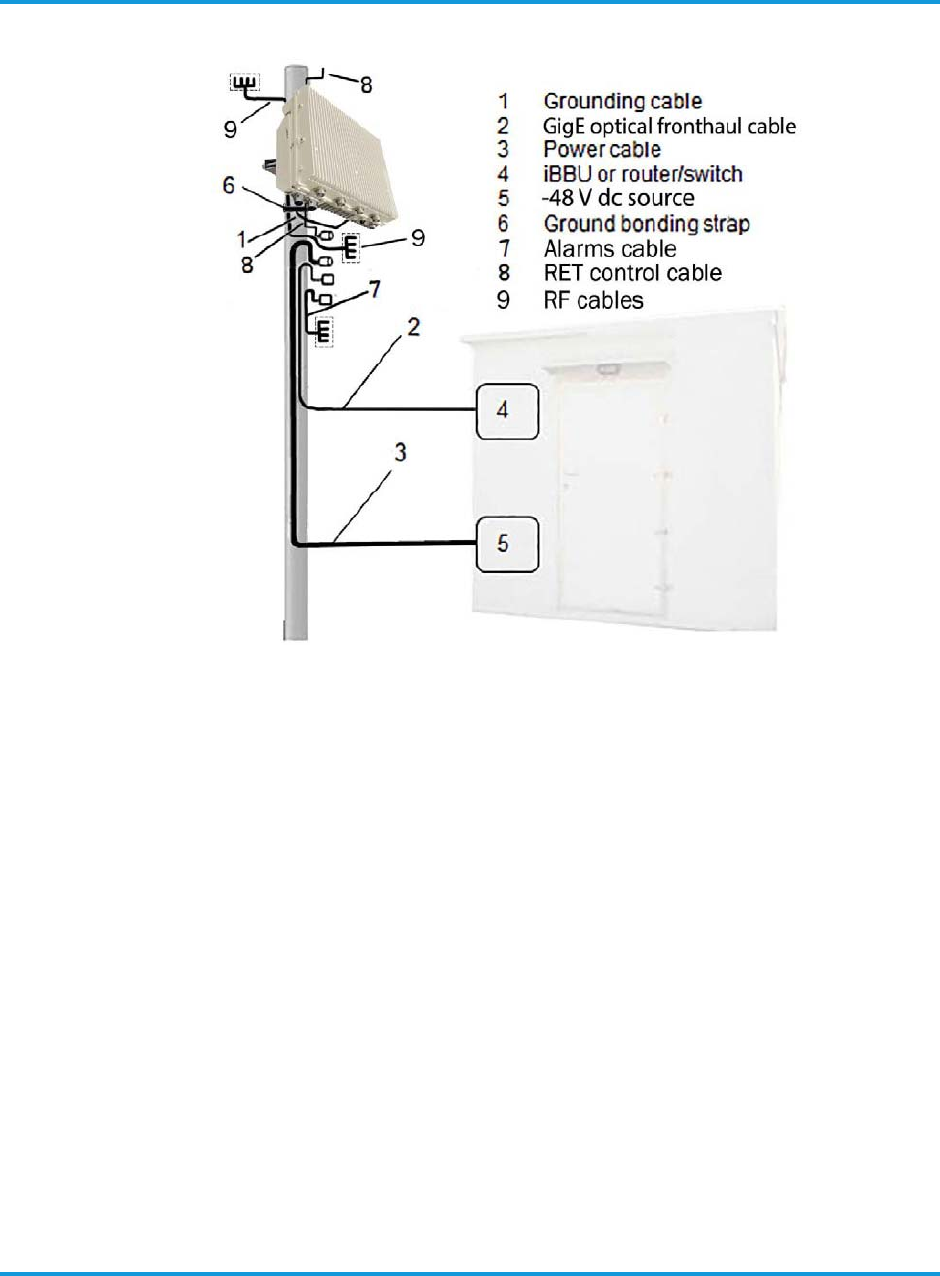
Installing the iRM4451nn00-2
iRM4451nn00-2 iRRH Product Description and Installation Guide 6-3
Figure 6-2 iRM4451nn00-2 cable routing
2. Secure and dress all cables according to local practice.
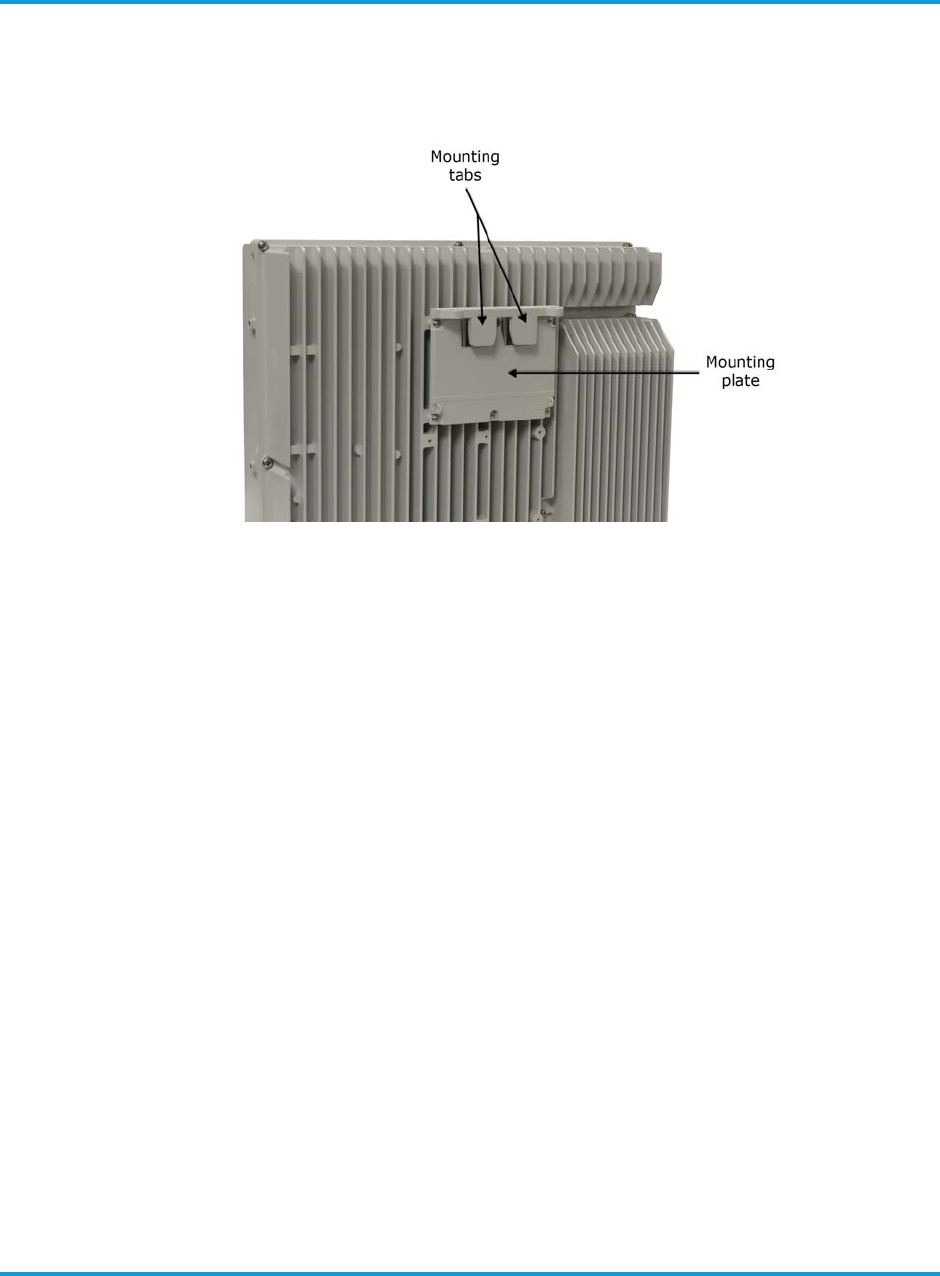
Installing the iRM4451nn00-2
6-4 iRM4451nn00-2 iRRH Product Description and Installation Guide
6.3 Installing the mounting bracket
The iRM4451nn00-2 is shipped from the factory with the mounting plate pre-installed
on the chassis as shown in Figure 6-3.
Figure 6-3 iRM4451nn00-2 mounting plate
6.3.1 Mounting on a pole/mast
The following procedure provided instructions for mounting the iRM4451nn00-2 on a
pole/mast using the supplied mounting bracket assembly.
To install mounting plate on a pole or mast:
1. Install the mounting bracket and mounting clamp onto the pole/mast with
mounting hardware as shown in Figure 6-4.

Installing the iRM4451nn00-2
iRM4451nn00-2 iRRH Product Description and Installation Guide 6-5
Figure 6-4 Installing mounting bracket on a pole
NOTE
IMPORTANT! Maintain the parallel orientation of the clamp and bracket while
tightening the nuts. This will require alternating tightening the M12-175 nuts on
each screw stud until the final torque, 29.5 ft-lb (40 Nm) is achieved.
6.3.2 Mounting on a wall
The following procedure provides instructions for mounting the iRM4451nn00-2 to a
wall or other flat, vertical surface.
NOTE
The wall where the iRM4451nn00-2 is to be mounted must be able to support
four times the weight of the unit. The unit can be mounted at a deviation from
vertical of ≤3°.
NOTE
The mounting clamp is not used when mounting the iRM4451nn00-2 to a wall or
other flat surface. In addition, the M12 bolts supplied in the hardware kit are not
used for wall-mount applications.

Installing the iRM4451nn00-2
6-6 iRM4451nn00-2 iRRH Product Description and Installation Guide
NOTE
The Installer must provide two (2) M12 anchors, designed for outdoor use, that
are compatible with the type structure on which the iRM4451nn00-2 is to be
installed.
To install mounting plate on a wall:
1. Determine the location where the mounting bracket is to be installed.
NOTE
The center-to-center distance for drilling holes to install the selected anchor is
5.5 in (140 mm).
2. Using a tape measure and spirit level, mark where the anchor will be installed
using a center punch.
3. Drill the holes where the anchor or fastener will be installed on the wall using a
drill bit sized for the anchor or fastener, and insert anchor or fastener.
4. Install the iRM4451nn00-2 mounting bracket to the wall using the two (2) selected
fasteners and supplied by the Installer.
5. Tighten the fastener to torque specified by the fastener/anchor manufacturer
using a torque wrench.
6.4 Hoisting the iRM4451nn00-2 on elevated structures
Hoist line eye bolt screw inserts are located on both sides and on top of the unit. The
recommended hoist line lift points for the iRM4451nn00-2 using the side screw inserts
is shown in Figure 6-5. Installing the hoist line lift eyebolts in the screw inserts on the
top of the unit (not shown) are also recommended. These are the ONLY recommended
points of attachment when hoisting the iRM4451nn00-2 into position on elevated
structures.
An Installer-supplied 2-leg nylon lift sling is attached to the eye bolts and the
iRM4451nn00-2 is lifted directly from the packing container to the mounting location.
WARNING
Because of the variation that may exist among mounting environments, the
Installer is solely responsible for determining an industry-approved, safe
method of hoisting the iRM4451nn00-2 into position onto elevated structures.
NOTE
A tag line, to control sway during the lift, can be attached to either eye bolt, or a
third eyebolt can be installed in one of the unused screw inserts located on the
sides of the unit.
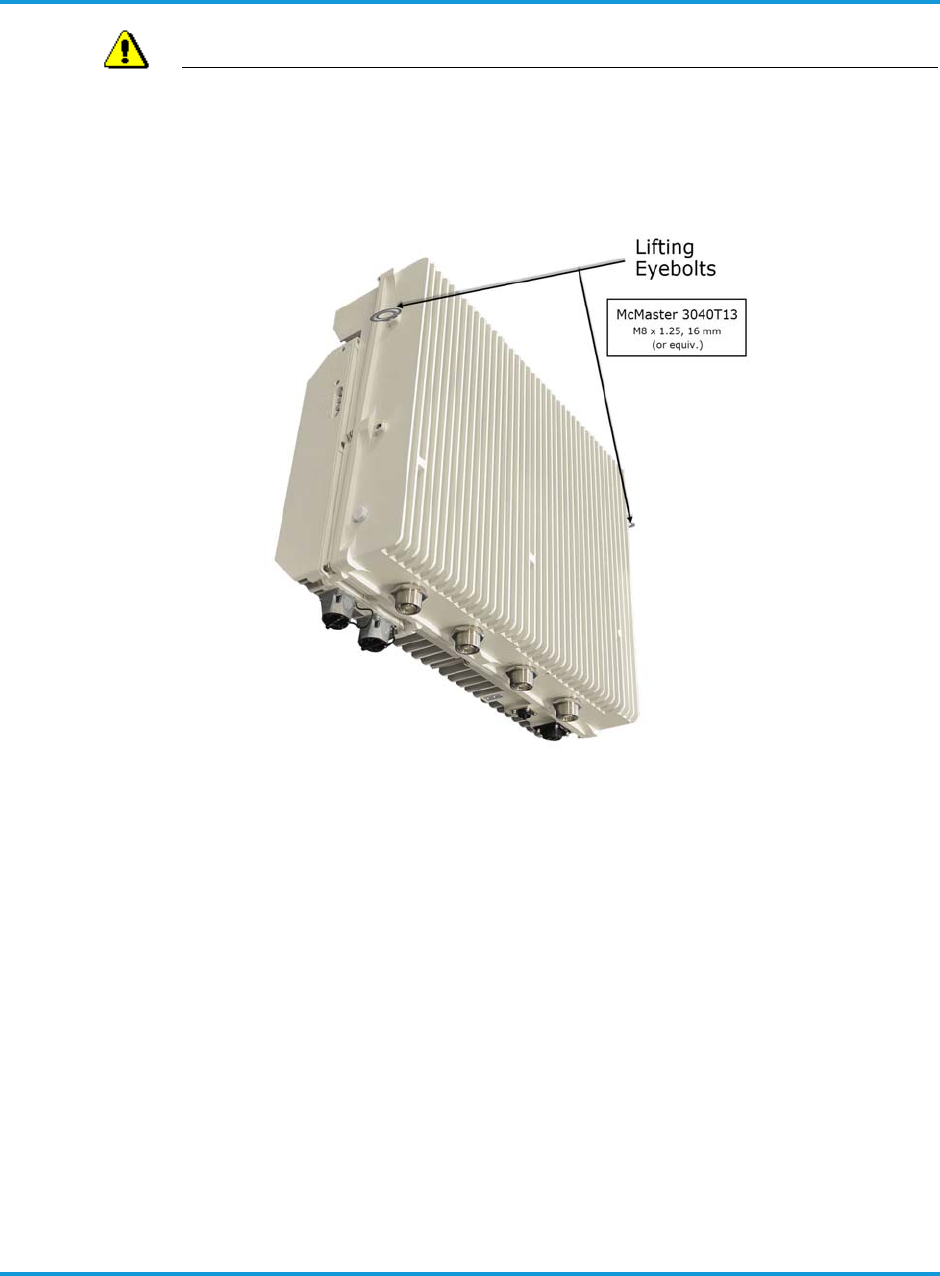
Installing the iRM4451nn00-2
iRM4451nn00-2 iRRH Product Description and Installation Guide 6-7
WARNING
Be sure to follow all established local practice and safety precautions when
hoisting the equipment on elevated structures.
Figure 6-5 Hoist line carabiner attachment points
6.5 Installing the iRM4451nn00-2 on the mounting bracket
This section provides the procedure for installing the iRM4451nn00-2 main unit on the
installed mounting bracket.
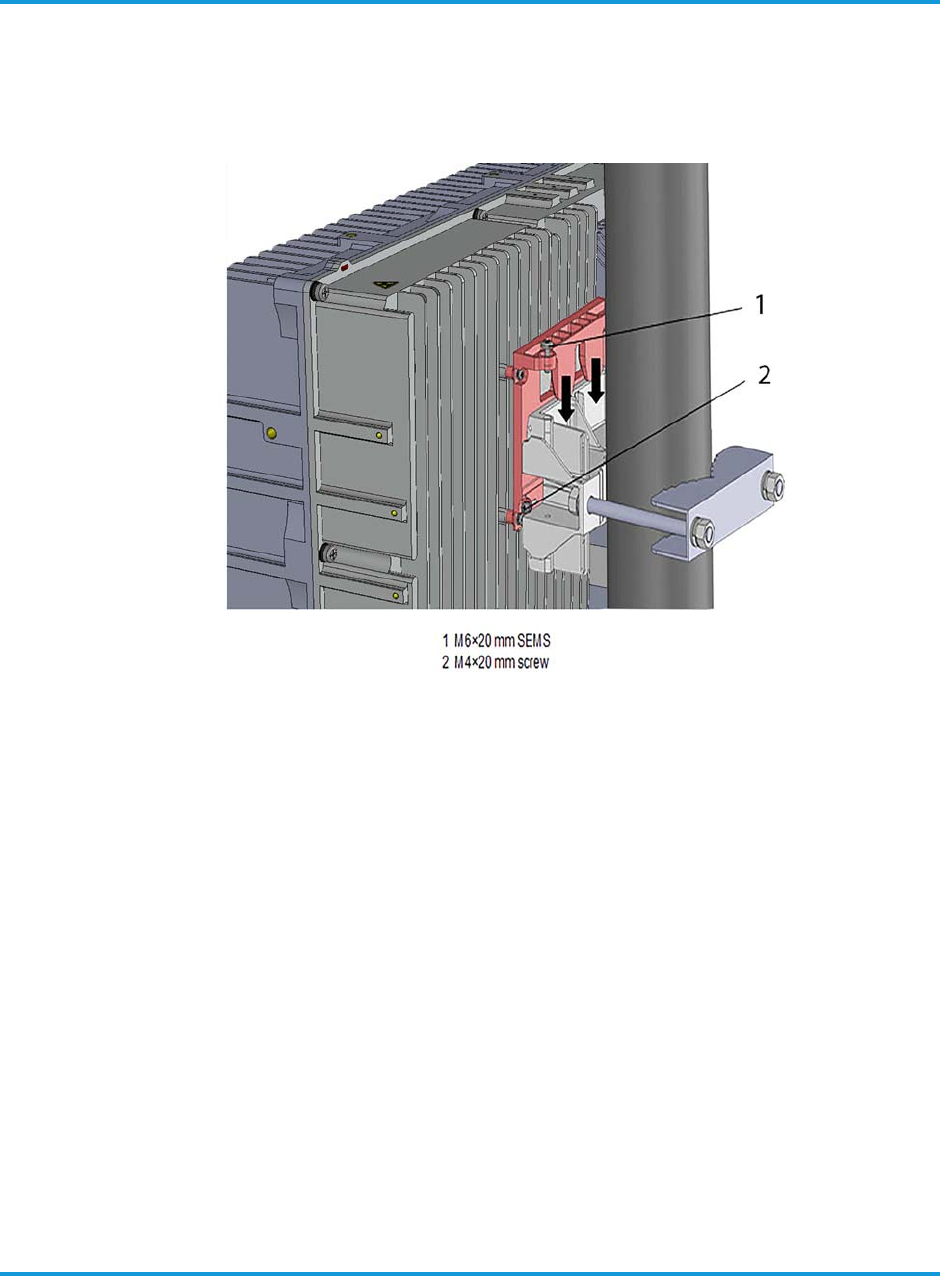
Installing the iRM4451nn00-2
6-8 iRM4451nn00-2 iRRH Product Description and Installation Guide
To install iRM4451nn00-2 on the mounting bracket:
1. Hang the iRM4451nn00-2 chassis on the mounting bracket by aligning the
mounting plate tabs on the rear of the chassis to the mounting bracket slots (see
Figure 6-6).
Figure 6-6 Aligning mounting plate tabs to mounting bracket
2. Lower iRM4451nn00-2 onto the mounting bracket and align the tapped screw hole
on top of the mounting plate with the tapped screw hole on the mounting bracket.
3. There are two (2) M6 × 20 mm SEMS captive screws on the top of the mounting
plate. See Figure 6-6. Start threading the M6 screws into the mounting bracket
screws. Do NOT fully tighten.
4. Insert two (2) M4 × 20 mm SEMS screws into the screw holes on either side of the
mounting plate.
5. Tighten the M4 screws on the side 13.3 in-lb (1.5 Nm) using a torque wrench.
6. Tighten the M6 screws to 9 in-lb (1 Nm) using a torque wrench.
6.6 Connecting the grounding cable
This section provides the procedure for properly grounding the iRM4451nn00-2 to an
earth grounding point. Verify that grounding cable/lug assembly is terminated at the
other end to a tested earth grounding point according to local practice.
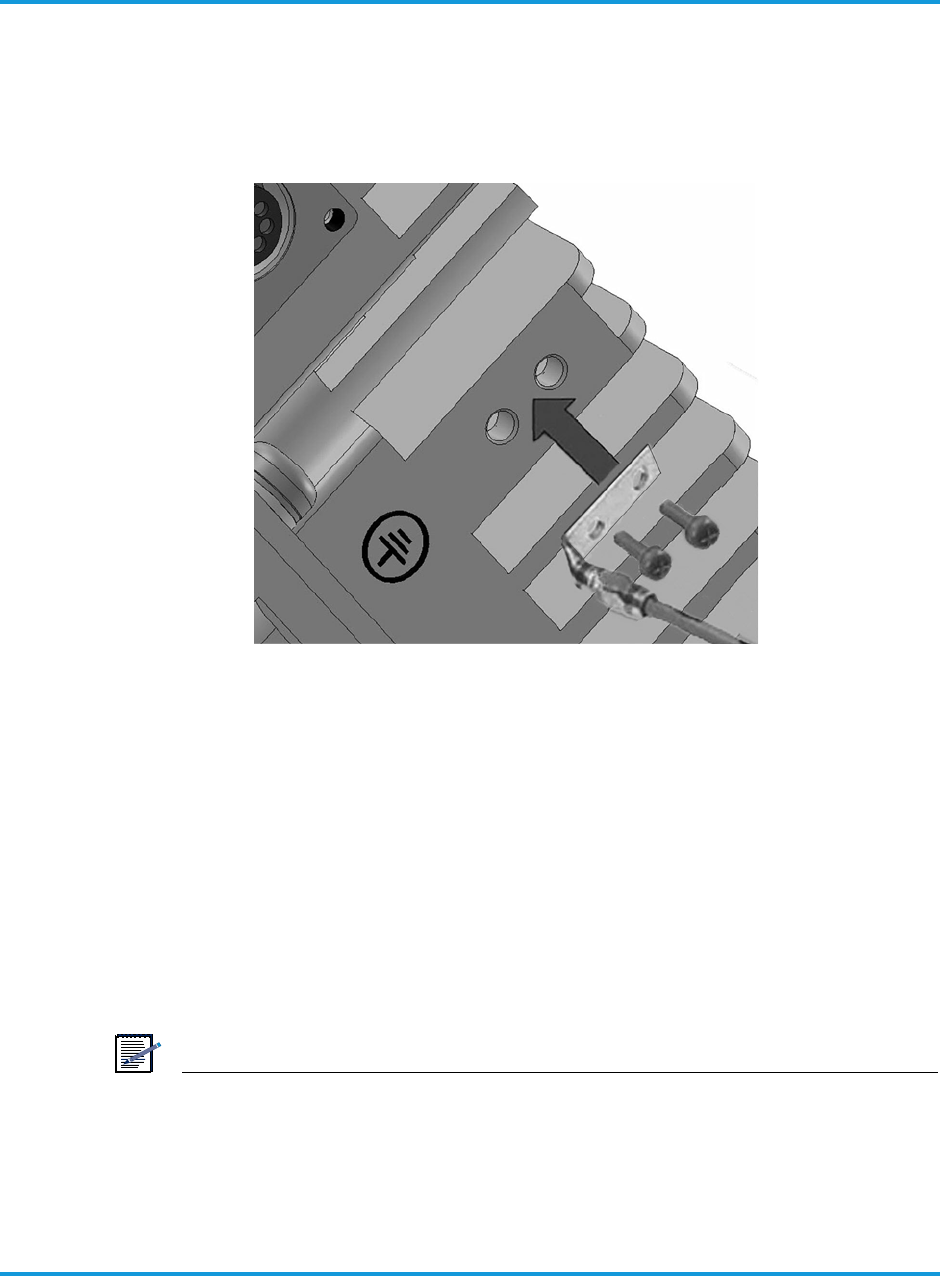
Installing the iRM4451nn00-2
iRM4451nn00-2 iRRH Product Description and Installation Guide 6-9
To connect grounding cable:
1. Fasten the dual-hole grounding lug and cable assembly to the iRM4451nn00-2
chassis grounding posts using two (2) M5-0.8 screws and washers (supplied by
Installer). See Figure 6-7.
Figure 6-7 Connecting the grounding cable
2. Tighten the bolts to 2.4 ft-lb (3.2 Nm) using a torque screwdriver.
6.7 Connecting the RET cables
This section provides the procedure for connecting the RET cable to the RET
connector socket.
To connect RET cable:
1. Insert RET cable into keyed 8-pin RET socket on iRM4451nn00-2.
2. Twist the ferrule of the RET connector clockwise until it audibly ‘clicks’ into the
locked position.
NOTE
It is recommended that the RET connection be waterproofed using a self-fusing
tape made for that purpose. The application of the tape will vary by Installer, so
local practice will determine how the tape is applied.

Installing the iRM4451nn00-2
6-10 iRM4451nn00-2 iRRH Product Description and Installation Guide
6.8 Connecting the GigE optical fronthaul cables
This section provides the procedure for connecting the GigE optical fronthaul cable to
the FH1 or FH2 SFP connector sockets. A set of detailed assembly instructions are
provided with each Rosenberger Fiber Enclosure. The instructions detail the assembly
of the enclosure over duplex fiber-optic cables..
To connect GigE optical fronthaul cables:
1. Remove the captive dust cover of the FH1 fiber optic cable entry port.
2. Remove the four (4) dust plugs on each of the duplex fiber ends and retain for
future use.
3. Insert the duplex into the SFP module recessed inside the FH1 bulkhead
connector until an audible ‘click’ is heard indicting the fiber is locked into the
module.
4. Store any slack of the fiber-optic cable inside the Rosenberger RFE plug to clear if
from getting pinched in the process of connecting the RFE plug to the bulkhead
connector.
5. Align the rails on the side of the Rosenberger RFE plug and push firmly until an
audible ‘click’ is heard indicating the RFE plug is locked into the bulkhead
connector completing the weatherproof seal..
6. If required, repeat step 1 through step 5 for the FH2 fiber optic cable entry port if
two Q-XCO fiber optic cables are used to daisy-chain or sidehaul to another
iRM4451nn00-2.
NOTE
The fronthaul Ethernet connections must be waterproofed using a self-fusing
tape made for that purpose. Refer to Required tools on page 4-1. Refer to the
recommended taping procedure in Section 6.12. The application of the tape may
vary by Installer local practice.
6.9 Connecting the RF cables
This section provides the procedure for connecting the 4.3-10 connectorized RF cables
to the iRM4451nn00-2 iRRH.
To connect the RF cables:
1. Remove the dust covers from the ANT1–ANT4 RF connectors located on the
bottom of the iRRH and retain for future use.
2. Screw the 4.3-10 RF cable coupling nut onto the ANT1 4.3-10 cable connector.
3. Secure the connection by torquing the coupling nut hand tight.
4. Repeat for connectors ANT2–ANT4.

Installing the iRM4451nn00-2
iRM4451nn00-2 iRRH Product Description and Installation Guide 6-11
6.10 Connecting the alarms cable
This section provides the procedure for connecting the alarms cable, terminated at
the macro iRRH with a Lumberg 0322 12 circular 12-pin DIN connector, to the
iRM4451nn00-2 iRRH.
To connect the alarms cable:
1. Remove the captive dust cover from the ALARMS connector located on the side of
the macro iRRH.
2. Screw the DIN connector coupling nut onto the ALARMS connector.
3. Secure the connection by torquing the coupling nut hand tight.
6.11 Connecting the –48 V dc power cable
This section provides the procedure for connecting the –48 V dc power cable to the
iRM4451nn00-2 power input connector. Detailed instructions on how to assemble the
power cable to the Rosenberger power connector are provided with the each plug.
Refer to them to install the power connector to the power cable.
NOTE
Power to the –48 V dc power supply cable should be switched off at the breaker
before connecting to the iRM4451nn00-2 power input connector.
To connect the dc power cable:
1. Plug the Rosenberger quick-disconnect power plug into the power input receptacle
labeled POWER located on the bottom of the unit by aligning the two bayonet
lugs into the slots of the coupling nut.
2. Secure the connection by twisting the coupling nut firmly clockwise by hand until
you feel and hear it ‘click’ into the locked position.
NOTE
It is recommended that the –48 V dc power connection be waterproofed using a
self-fusing tape made for that purpose. The application of the tape will vary by
Installer, so local practice will determine how the tape is applied.
6.12 Weatherproofing cable connections
This section provides the procedure for additional weatherproofing of all cable
connections (power, RET, RF, fronthaul, and alarms) to ensure a weather-tight cable
connection is maintained.
To weatherproof cable connections:
1. Weatherproof all cable connections by completely wrapping the cable, the
connector on the cable, and the connector threads on the equipment itself with
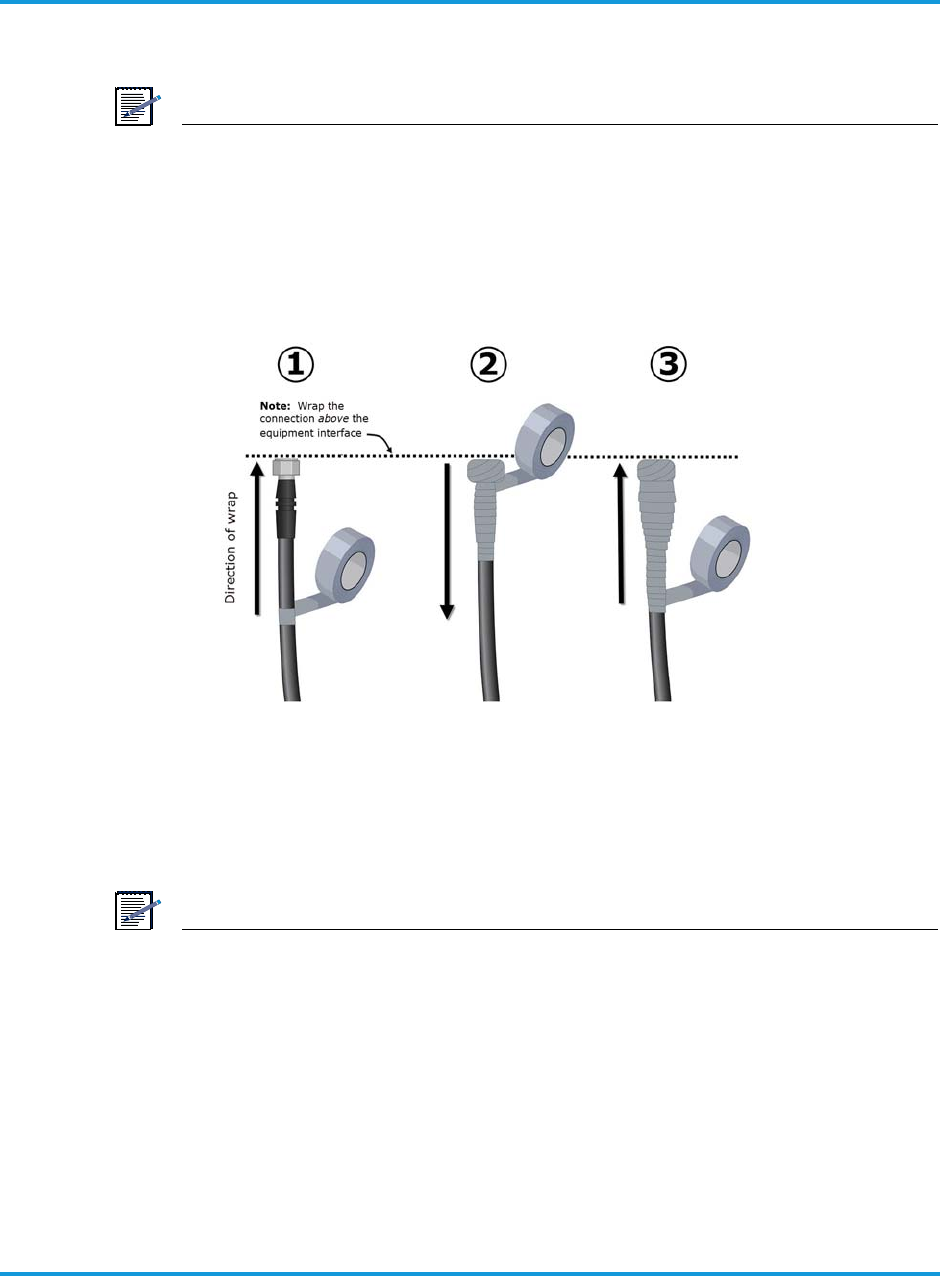
Installing the iRM4451nn00-2
6-12 iRM4451nn00-2 iRRH Product Description and Installation Guide
self-fusing tape (refer to Required tools on page 4-1) as shown in Figure 6-8, or
according to local practice.
NOTE
To ensure a weather-tight connection, be sure to wrap the entire connection with
self-fusing tape. Refer to the recommended taping procedure in Section 6.12.
TIP: It can be hard to remove the self-fusing tape from the connection after it
has weathered over time. So as an alternative, some Installers prefer to use
electrical tape, such as Scotch Super 33+ (or equivalent), when wrapping the
first layer around the cable and connection.
Figure 6-8 Weatherproofing connections using self-fusing tape
6.13 Checking power
This section provides the procedure for verifying power to the iRM4451nn00-2 is
connected correctly and operating normally.
NOTE
After applying –48 V dc power and verifying that the iRM4451nn00-2 is
functioning properly, leave power to the unit ON.
To check power to the macro iRRU:
1. Switch ON the breaker (or insert the appropriate size and type of fuse) to provide
power to the iRM4451nn00-2 iRRH.
2. Verify that the iRM4451nn00-2 powers up as indicated by the LEDs on the side of
the iRM4451nn00-2 lighting in the boot sequence provided in Table 3-6.
3. Leave power to the iRM4451nn00-2 ON.

Terms, Acronyms and Abbreviations
iRM4451nn00-2 iRRH Product Description and Installation Guide 7-1
7 Terms, Acronyms and Abbreviations
Term Description
AWG American Wire Gauge
AWS Advanced Wireless Services
BBU Baseband Unit
BOM Bill of Materials
CBN Common Bonding Network
CFR Code of federal regulations
C-RAN Cloud-Radio Access Network
DIN Digital Input
EIPS Electronics Industry Pallet Specification
EMS Enterprise Management System
EN Engineering Note
FO Fiber Optic
FTTA Fiber-To-The-Antenna
GigE Gigabit Ethernet
GPS Global Positioning System
iBBU intelligent Baseband Unit
IEC International Electrical Code
iRRH intelligent Remote Radio Head
LED Light Emitting Diode
PN Part Number
NA Not Applicable

Terms, Acronyms and Abbreviations
7-2 iRM4451nn00-2 iRRH Product Description and Installation Guide
RET Remote Antenna Tilt
RF Radio Frequency
RFE Rosenberger Fiber Enclosure
RX Receive
SEMS Screw and Washer Assemblies
SS Stainless Steel
TX Transmit
vBBU virtual Baseband Unit
VDC or V dc Voltage direct current
Term Description


iRM4451nn00-2 iRRH Product Description and Installation Guide
Revision 1.2
240-00-0051
Copyright © 2017 Altiostar Networks, Inc.